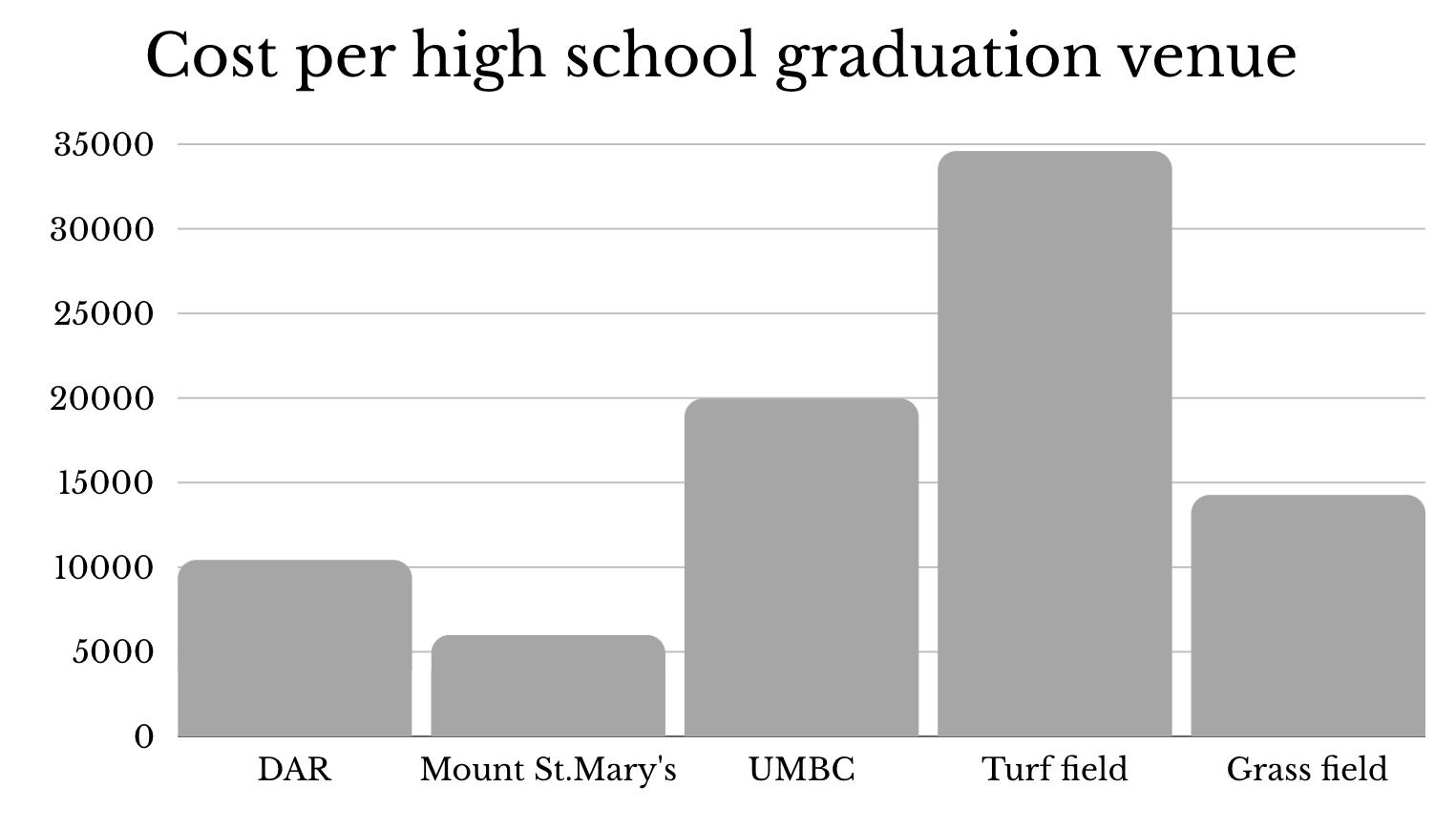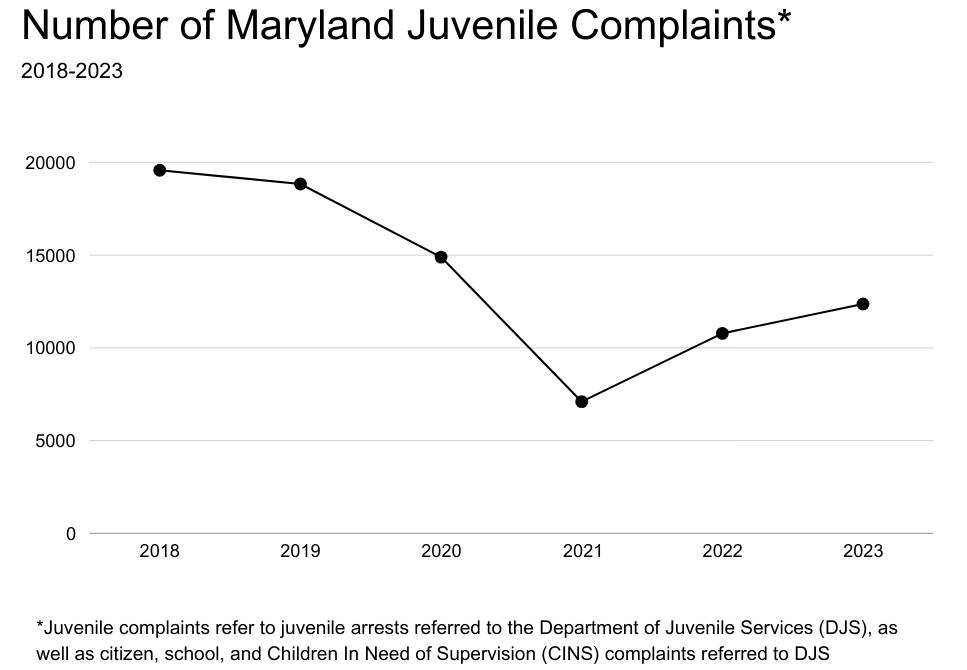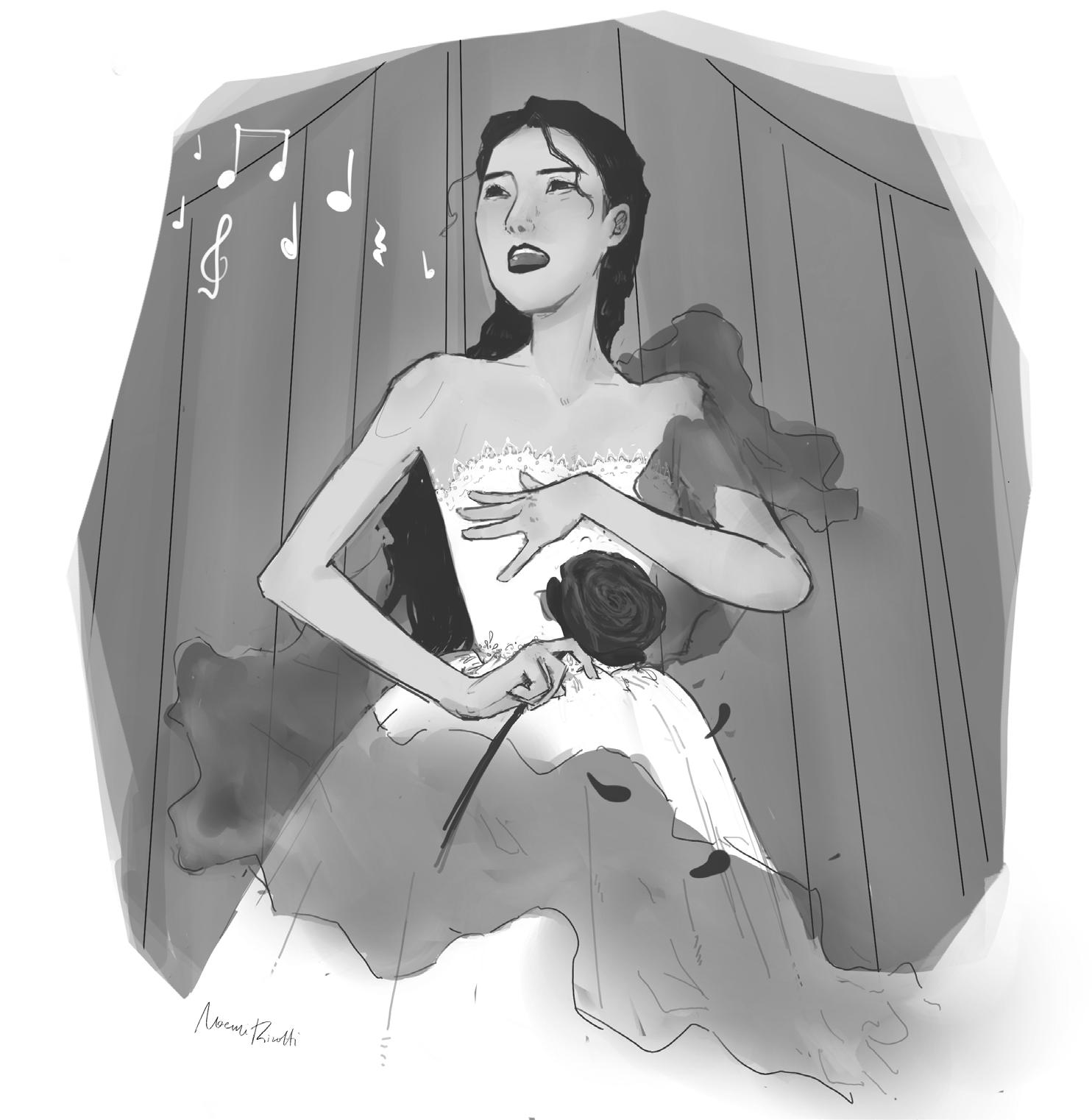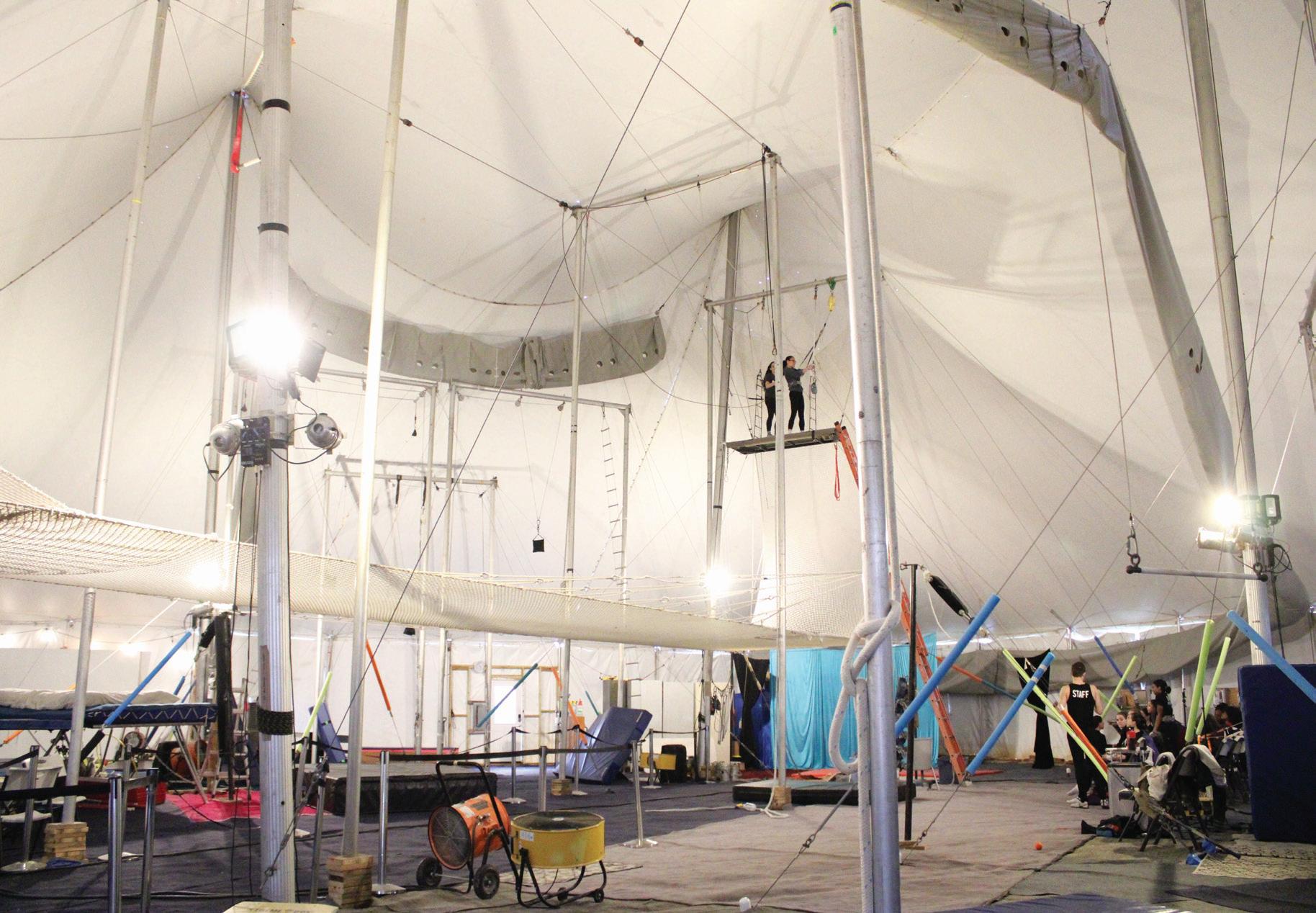
BY
PARTIAL SOLAR ECLIPSE On April 8, crowds gathered at the National Mall in Washington, D.C. to witness a solar eclipse. The next total solar eclipse that can be seen from the contiguous U.S. will be on Aug. 23, 2044.


BY
PARTIAL SOLAR ECLIPSE On April 8, crowds gathered at the National Mall in Washington, D.C. to witness a solar eclipse. The next total solar eclipse that can be seen from the contiguous U.S. will be on Aug. 23, 2044.
Earlier this school year, Blair informed seniors that their graduation ceremony fee would be set at $60. Later, MCPS announced graduation subsidies. However, as Blair had already set the fee, administration collected more than graduation is estimated to cost.
In a new system that began this school year, MCPS will subsidize graduation venue costs for high schools based on the percentage of the school’s students receiving Free and Reduced-Price Meals (FARMS). As per a Sept. 28 memo sent to all high school principals, high schools with a FARMS rate lower than 20 percent would receive a 25 percent subsidy, those with a FARMS rate between 20 and 35 percent would receive a 50 percent subsidy and those with a FARMS rate above 35 percent would receive a 75 percent subsidy.
Dyan Gomez, the supervisor of the School and Financial Operations Team in the MCPS Office of Finance, said that the county used to give money to high schools based on their graduation venue.
“In the past years, we did not delineate any differences based on FARMS rates. So it used to be a set cost, … so we looked at it more about the cost of the venue, not so much differentiating between the needs of the schools,” she said.
In a county document obtained by Silver Chips, MCPS found Blair’s FARMS rate to be between 20 and 35 percent, allocating a $17,299.40 subsidy for graduation, 50 percent of the total cost of graduating on Blair’s turf stadium—$34,599, as of March 4. However, in an interview with Silver Chips, Blair Principal Renay Johnson stated that Blair’s FARMS rate is actually 47.1 percent and MCPS had miscalculated. Based on the system, Blair’s correct FARMS rate makes it eligible for a 75 percent subsidy.
Despite the fact that the county
sent a memo to her office, Johnson was not aware of the new system. “I don’t recall them saying the higher your FARMS rate, the more we’ll pay. And maybe it was a discrete line item. I’m not sure why, but I wasn’t aware of that,” she said. After Silver Chips informed Johnson about the mistake in a March 5 interview, she notified the MCPS Central Office, who later corrected the FARMS rate and Blair’s subsidy accordingly on the countywide graduation venue cost document. “I sent an email to an MCPS staff person … and they wrote back and they said I’m sorry your FARMS rate was put in incorrectly,” Johnson said, “And so I was stunned, because you assume that the folks in the [central] offices understand the FARMS rate and [that] they are putting in the correct data.”
Gomez explained that she noted the incorrect FARMS rate. “The only issue we made [was that] I had the wrong FARMS category for Blair,” Gomez said.
On a Saturday in a packed restaurant in Southeast Washington, D.C. between midnight and 4 a.m., the music never stops. 750 people manage to squeeze into a room that seats 250, engulfing the band, united as one. The band starts to gradually build up their beat and calls out to the crowd asking if they are ready. The crowd responds eagerly; signaling the start of the performance. Bodies are pressed up against each other dancing. The crowd sings in unison, their voices echoing through the building. This is go-go. Go-go music originated in the 1970s in Washington, D.C. as a subgenre extension of funk music. Go-go bands are typically composed of drums, congas, tambourines, cowbells, keyboards, electric guitars, and vocalists. The percussionists and guitarists make up the backline. Once the backline starts playing, the music never
The feminist rock band’s evolution since it originated out of the
ends. Go-go famously got its name from keeping people on the dance floor, ‘going and going.’ The music is centered around the go-go beat called the ‘pocket,’—the beat that allows songs to continue infinitely. One of the most important roles in a go-go band is the ‘lead talker’ or ‘lead mic.’ The lead talker interacts with the crowd to maintain engagement. The lead talker does the ‘call and response’ which is vital to a go-go performance. Call and response creates an intimate relationship with the band and the fans. For instance, before the music starts, the lead talker goes around in the audience to meet new people and to see if there are any celebrations or birthdays to call out during the show. If the lead talker sees that the audience is not dancing, they signal to the band to stop playing. Then, the percussionists go into the pocket beat and the lead talker starts to call out people they know in the room.
Spring fling canceled due to low ticket sales
On April 11, Blair students and teachers heard over the PA system that the annual Spring Fling was canceled due to low ticket sales. According to Blair SGA president Cate Sauri, the dance did not have the necessary number of students who bought tickets to warrant its expense. “The amount of resources of ours that it required wouldn’t be worth the amount of students it would service,” she said. Despite this setback, the SGA is still dedicated to serving the Blair community in the future. “Our purpose as a student government organization is to serve our students and create events that bring our community together,” Sauri said.
from GRADUATION page A1
Gomez went on to say, “I guess I didn’t look at the information closely. I had [Blair] in the wrong category of the discount, for lack of a better word.” Blair will now receive $8,814 more than accounted for when the subsidies were first released, but the additional funding had no effect on seniors’ graduation fees. Neither the Blair administration, nor MCPS has made students and parents aware of the mistakes.
Like Johnson, Blair’s senior class sponsor Roxanne Fus was unaware of Blair’s subsidy when Silver Chips first approached her. “They have not told us how much money they’re going to give us this year … To be honest with you, the county starts this process way too late, because I need to order caps and gowns by December or January at the latest … and we have to collect the money to pay for graduation at the same time,” she said in a Feb. 29 interview.

on location.
puncture the field.
Praneel Suvarna wins 47th SMOB election
MCPS students elected Clarksburg junior Praneel Suvarna to be their 47th Student Member of the Board (SMOB) on April 17. More than 58,927 MCPS middle and high school students cast ballots. The SMOB serves as a voting member of the BOE, but cannot vote on negative personnel issues. According to an MCPS press release, Suvarna received 53 percent of the vote and his opponent, Blair junior Sam Ross received 47 percent. Suvarna has said numerous times that his first priority is addressing the opioid crisis by calling for security guards to be equipped with Narcan.
Northwood move frustrates students and parents
At an April 10 meeting about MCPS’ proposed plans regarding Northwood students’ expected move to Charles W. Woodward High School for the next three years, Northwood students and parents voiced annoyance and exasperation. Points of contention included the county’s plans to start school for Woodward students at 7:25, and a lack of resources for students. Woodward currently does not have an auditorium or finished athletic fields, meaning that student athletes will have to be bused to local parks for practice. Aside from sports that can be held inside the gymnasium, all athletic events will be held at opposing schools. MCPS acting Chief of Schools, Peter Moran, acknowledged that the county needed to hold a follow up meeting to address parental concerns.
Blair was not the only administration that was unaware of the new system. “I was not aware of any financial subsidy that would come from MCPS … this is the first I’m learning of it,” Bethesda-Chevy Chase (B-CC) graduation coordinator Daniel Janis wrote in an email to Silver Chips.
I don’t recall them saying the higher your FARMS rate, the more we’ll pay ... I’m not sure why, but I wasn’t aware of that.
Blair’s total student graduation fee is the highest in the county, only matched by Walt Whitman. The largest contributing cost to this fee is that Blair currently holds its graduation ceremony on Blazer Stadium’s turf field. According to Johnson, Blair students and families would not fit in any of the venues provided by MCPS. “We’re too big for Constitution Hall, [students] would get like two tickets, at [University of Maryland Baltimore Campus (UMBC) students would get] three tickets,” Johnson said. Since 2021, Blair has held graduation outdoors on their turf and has continued to do so. “After COVID, we all did outdoor graduations at all high schools in Montgomery County. But then it worked for us, so we continue to have it outside,” Johnson said. A turf field is the most expensive graduation location in MCPS due to the necessity of turf safe equipment that will not
In addition to the $60 ceremony fee, Blair students must pay $50 for a new cap and gown. Graduating seniors at Blair are not allowed to wear previous graduates’ caps and gowns, commonly provided by friends or siblings. Roxanne Fus explained the difficulties in implementing a system where students could borrow caps and gowns from years prior. “We don’t have the storage for it, and we don’t have the manpower for it,” she said. Additionally, Johnson claims that the gown colors changed slightly each year. “The color variation was always slightly off,” Johnson said. The changes ultimately led to the elimination of cap and gown sharing. “We just said no across the board,” Johnson said.
While some MCPS high schools also require students to purchase a new cap and gown, Winston Churchill and B-CC among others allow students to rewear them. “We encourage recycling cap and gown from previous years, dating back to the class of 2019-2020 when we changed from black gowns to blue gowns. The only purchase needed in that case would be the tassel, which costs around $8 and includes the current graduation year,” Janis wrote.
Blair’s graduation cost has caused financial strain for some students. John Gregor Ayala, a Blair senior who supports himself financially after the death of his parents, found the cost of graduation to be burdensome. “I wouldn’t say I can easily pay for it … it’s barely affordable … especially with my financial situation,” he said. Fus explained that Blair has protocol in place for students who need financial assistance. “We don’t turn
people away because they can’t afford the cap and gown ever … we try to not make it an embarrassing situation. They can go to their counselor, they can go to Ms. [Adriana Burgos-Ojeda], the senior class administrator, Ms. Johnson, myself, Ms. [Joellyn] Gil,” she said. However, even with those systems in place, a Blair teacher paid for Gregor Ayala’s graduation fee. According to Blair administration, in 2023, the school spent approximately $20,000 on decorations, programs, flowers, security, yard signs, and staff shirts. MCPS updated subsidy information to reflect the current venue costs for a turf field, calculated at $35,258, meaning that Blair will pay $8,814 for stage and sound. Including the 75 percent subsidy and additional spendings, Blair’s total graduation cost is estimated to be approximately $29,000. If 740 seniors paid the $60 ceremony cost, Blair would have collected $44,400. Based on these estimates, the school should have a surplus of approximately $15,400.
I
wouldn’t say I can easily pay for
it
… it’s barely affordable … especially with my financial situation.
The form outlining graduation fees listed that “all excess money from donations, etc. will be donated to MBHS for student programs.” In the past, the
senior class officers have asked Blair administration to put excess money toward the school. “So if we have leftover money, the senior class officers generally will write a letter to Ms. Fus or to the senior class sponsors … saying that ‘we would like the remaining funds to be used to purchase a bench for the class of 2024. We would like the remaining funds to be used for extra cafeteria tables.’ So we do do that,” Johnson said. The SGA has not yet officially decided what they would like to donate to the school if granted the option. “Our officers chose not to establish a class council, so I don’t really know how that would be decided,” SGA president Cate Sauri said. Although a customary practice, a large surplus has been favored by seniors as a call for reimbursement rather than a donation to the school. “[They] should reimburse the students because the seniors aren’t going to be here anymore. So the money that goes into the school won’t be used on them,” Blair senior Paul Marino said. According to Gomez, MCPS policy is to refund students in the case that they have overpaid. “I’ve been told that they should reimburse students if the cost is lower than what they pay for any kind of thing that they’re collecting from students,” Gomez said. Based on estimates, if the surplus were returned to students, each paying senior would receive approximately $20. At the moment, there are no plans in place to refund students.

According to the Maryland State Department of Education, MCPS’ four-year graduation rate for the 2022-2023 school year was 89.6 percent. The data, released on March 26, demonstrates a slight decrease of 0.7 percentage points from the previous year, remaining 3.8 percent higher than the average graduation rate in Maryland. Over 12,000 students in Montgomery County graduated from high school in 2023.
A graduation cohort refers to students that start as first time ninth graders in a specific school year. A four-year graduation rate describes the amount of students in a graduation cohort that complete and graduate after four years of high school.
Graduation rates in MCPS are calculated with the Four-Year Adjusted Cohort Graduation Rate, which tracks a group of students from the start of ninth grade and adjusts for student transfers. This base rate is adapted in MCPS’ Equity Accountability Model and includes additional considerations of English Language Learners entering high school with lower English proficiency, as well as special education students. “[They] usually [measure] four years from the start of high school,” Blair English language development teacher Debra Adler said. “And then there’s also a five year rate.”
Despite an overall decrease in graduation rates, several student subgroups experienced increases in graduation rates compared to the previous year. Students who received FARMS services saw an increase of 2.8 percent, students
who are two or more races saw an increase of 2.6 percent, students who were part of Individualized Education Programs (IEPs) saw an increase of 2.5 percent, and Black students saw an increase of 0.3 percent in terms of graduation rates.
Historically, MCPS has had high graduation rates, maintaining a high rate of approximately 90 percent until 2018 when it decreased to 87.7 percent. In 2013, MCPS was recognized for having one of the highest graduation rates among the nation’s largest school districts, with an 87.4 percent graduation rate.
In the 2021-2022 school year, MCPS saw a slight rise in graduation rates. The end of the COVID-19 pandemic emphasized a need for social emotional support, and the county implemented more mental health resources that have remained in place since, such as the Be Well 365 plan, Social Emotional Learning lessons, and additional mental health awareness initiatives. As part of the post-pandemic phase, MCPS also enacted policies that led to more flexible grading, which factored into graduation rates. These policies included the 50 percent policy that guaranteed a minimum grade of 50 percent on any assignment regardless of completion, submission, or accuracy.
Recent events within the county such as the pandemic, grading policy changes, and the opioid crisis in MCPS, have all affected students’ mentality toward school.
“The drug addiction [problem is] becoming more prominent in this area,” Blair junior Gabrielle Taylor said. “I’ve noticed that a lot of kids have started doing opioids
 By Raunak Banerjee News Columnist
By Raunak Banerjee News Columnist
On April 8, Blair students eagerly left their classes, school-issued eclipse glasses in hand, to witness the captivating solar eclipse. Meanwhile, across the globe, scientists were employing a myriad of tools and techniques beyond mere glasses to observe and study the celestial event.
A solar eclipse occurs when the moon aligns perfectly with the sun, casting its shadow onto the Earth below. Perfect alignment results in what is known as totality, where the moon passes between the sun and earth, obscuring the sun and creating the surreal experience of seeing the stars in the middle of the day. The path of totality covered some American cities including Austin, Dallas, Indianapolis, Cleveland, and more where millions had the

and smoking marijuana and stuff like that [which] leads them to be off track.” During the 2022-2023 school year, 18 students received Narcan for possible opioid overdoses, and over 15 MCPS students have died due to fentanyl overdoses in the past two years.
The COVID-19 pandemic resulted in a significant increase in absenteeism across the county and many students experienced isolation as well as a lack of motivation.
“I feel like after quarantine, a lot of students just lost motivation,” Taylor said. Over 35.79 percent of high school students in MCPS were chronically absent during the 2022-2023 school year, which was over 5 percent more than the 2018-2019 school year at 29.48 percent.
Students suggest that schools promote convenient resources in order to support students throughout high school. “I feel like there’s
privilege to witness this awe-inspiring phenomenon.
Today, taking advantage of totality is vital for studying the sun’s atmosphere. During totality, when the moon obscures 100 percent of the sun, viewers can see the sun’s atmosphere or corona with their naked eye. For scientists, the eclipse is key to making discoveries regarding the sun’s heat and energy transfer. With high-power telescopes, The National Aeronautics and Space Administration (NASA) captured intricate images of solar flares erupting from the sun’s corona during the eclipse. Solar flares, an explosion on the sun, are often capable of impacting electrical grids and satellite communications. Similarly, the ESA (European Space Agency) has launched its own probe to study the corona. Building upon the research conducted during the 2017 eclipse, NASA also began funding various research initiatives, including the deployment of cameras aboard high-altitude research planes and utilizing ham radios, to further understand the sun’s atmospheric behavior. This will allow scientists

not really much you can do because when people want help, they can get help. But people don’t really want help,” Taylor said. “I feel like Blair could help support students by giving them maybe free rehab and stuff like that.”
Despite a series of different events throughout the past ten years, including the COVID-19 pandemic, the removal of final exams, and grading policy changes, MCPS graduation rates have remained largely the same.
“The pandemic and the shift to virtual learning certainly impacted the Class of 2023, and these numbers reflect that,” Interim Superintendent Monique Felder, said in a public statement to the county.
“Despite a marginal .07 percent decline in our district wide graduation rate … we maintain unwavering confidence in our capacity to surmount this minor setback in the years ahead.”
to work to prevent damage to electrical grids and satellite communications.
Biologists and ecologists also studied animal behavior during totality. The drastic change from day to an almost night-like state helps these scientists understand how life on Earth is affected during an eclipse. Eclipse Soundscapes, a NASA Citizen Science project, is dedicated to recording sounds of wildlife in eclipse zones. NASA begins by sending kits to volunteers who build recording devices in designated areas, which are activated roughly half an hour before totality. By analyzing these recordings, scientists can understand how nocturnal animals reacted in different areas depending on how much human involvement there was.
Despite occurring approximately every 18 months, witnessing a solar eclipse remains a rare event, as it is often only visible from the middle of the ocean or from uninhabited land masses, like forests or deserts. Another eclipse in the continental U.S. is not anticipated for another twenty years.
Compiled by Ethan de Brauw Staff WriterAn Israeli aircraft bombed an Iranian diplomatic facility in Damascus, Syria, on April 1, killing seven military officials. In an act of retaliation, on April 13, Iran fired several hundred drones and missiles into Israeli territory. With the help of the U.S. and other allies in the region, Israel intercepted the vast majority of Iranian missiles and drones, with only minor damage inside the Israeli state. On April 19, Israeli military retaliated, striking an Iranian military base near the city of Isfashan.
The U.S. made an effort to distance themselves from Israel’s attack, saying they were not warned before the strike in Damascus. In the wake of Iran’s retaliation, the U.S. publicly pressured Israel not to respond. Since Israel’s retaliatory strike against the Iranian military base, both sides have downplayed the impact, with Iranian authorities claiming there was “no damage.”
uncovers Russian interference in European elections
Belgian Prime Minister Alexander De Croo announced on April 12 that Belgian intelligence services had uncovered evidence of Russian interference in European elections, attempting to weaken support for Ukraine. De Croo also said that Belgian authorities would launch an investigation into alleged payments to European Parliament members by the Russian government, after an investigation revealed that European Parliament members were offered payment to promote Russian propaganda. De Croo said that Belgian officials are working very closely with Czech authorities after they uncovered a Pro-Russian influence campaign in Czechia. The announcements come after U.S. investigations revealed Russian interference in the 2016 and 2020 U.S. presidential elections in favor of Donald Trump.
U.S. strengthens economic and political relations with the Philippines
The United States, Japan, and the Philippines further strengthened their economic and political collaborations on April 13 against the backdrop of rising tension in Southeast Asia. Their cooperation aims to counter Chinese influence in the region.
The agreement not only strengthens defensive bonds between the countries, but also promises economic rewards for the Philippines, with the U.S. promising $100 billion in investments in the nation.
The agreement further encourages U.S. semiconductor manufacturers to open plants in the Philippines. The U.S. aims to diversify from the China and Taiwan focused semiconductor market.
Four MCPS elementary schools: Brookhaven, Oak View, Viers Mill, and Strathmore, will no longer receive Title 1 funding for the 2024-2025 school year due to MCPS’ change in criteria for Title 1 qualification. The loss of Title 1 funding, announced in February, will cause challenges to these schools, who currently rely on the funding to offer family engagement programs and procure instructional and school materials.
Title 1 is a federal grant program that is part of the Every Student Succeeds Act of 2015 and provides funds to schools whose poverty percentage is over 75 percent.
For the 2023-2024 school year, Brookhaven received $356,200 from Title 1 funding, Oak View received $397,800, Viers Mill received $517,400, and Strathmore received $462,800. Title 1 also provides schools with Extended Learning Opportunities Summer Adventures in Learning, which is a four week summer program for rising Kindergarten through eighth grade students enrolled in a Title 1 school.
Every year, schools are evaluated to determine if they are eligible to receive Title 1 funding. Previously, Title 1 status was determined by the number of students receiving Free and Reduced-Price Meals (FARMS). However, there are 58 MCPS schools currently under the Community Eligibility Provision (CEP), which allows students to automatically receive free meals
based on the percentage of the school community’s participation in food assistance programs. As a result, many parents with students at CEP schools stopped filling out the FARMS form, meaning that MCPS did not receive accurate data to determine if a school meets the true criteria on the Title 1 list.
“For [the CEP] schools, parents and students are not doing FARMS applications because they didn’t need to because everyone was getting free meals already,” Danielle Ring, the PTA President at Bel Pre said.
The big difference this particular year was the change in the criteria being used to qualify [Title 1 schools] and kind of a lack of communication from MCPS to those schools about what that status might look like and the potential impact.
Now, for the CEP schools, Title 1 eligibility is calculated using a formula that is applied to the number of students who qualify for direct certification, which is based on the student’s household participation in Supplemental Nutri-
tion Assistance Program (SNAP), Temporary Cash Assistance (TCA) program, or are identified as Foster Free, Head Start Free, or Medicaid. For non-CEP schools, Title 1 eligibility is calculated using FARMS data. Brookhaven, Oak View, Viers Mill, and Strathmore are all CEP schools.
Ring explained that the change in the evaluation process upset community members at the schools that will lose funding. “The big difference this particular year was the change in the criteria being used to qualify [Title 1 schools] and kind of a lack of communication from MCPS to those schools about what that status might look like and the potential impact,” she said.
Ring believes that without Title 1 funding, many students will not receive the help they need to do well in school. “The biggest challenge is that many of our lower income students need additional support and families don’t have the resources to provide them additional support. So [Title 1] gives the schools the ability to provide more direct academic, social, and emotional support to all the students in the school, but in particular, the students who are generally designated as higher need,” she said.
A commonality between the four schools losing Title 1 is that they are Community Schools, meaning they collaborate with community and local government members and other stakeholders to provide learning opportunities, and the schools will receive grants under Blueprint for Maryland’s Future, the state’s educational reform
legislation. The schools have also been designated as focus schools, which is the status under Title 1, so that class sizes will remain small.
Another consequence of the loss of funding will occur at Strathmore, as its lower elementary feeder school—Bel Pre—will retain Title 1 status. Sara Foraker, Blair teacher and Strathmore parent, believes that it is unfair for families who have children going to Strathmore from Bel Pre because they will lose the additional support that Title 1 provides when transitioning schools. “The same families go to Bel Pre and then go to Strathmore … Students who are from the same family but go to third grade, automatically lose those supports, which doesn’t make any sense,” she said.
All four of the impacted schools’ PTAs and staff members joined to-
gether to advocate for additional support for their students. “[The PTAs and staff members] raised awareness about the whole process, how Title 1 funding is allocated. I think that it has come to the attention of our Interim Superintendent about how she wants to do this differently next year,” BOE President Karla Silvestre said in an interview with Silver Chips. Foraker believes that MCPS’ change in determining Title 1 eligibility was not thorough and that the county should reexamine the process. “I think it probably just has to do with the bottom line: money. And unfortunately families and children are being affected by it … I will say maybe they didn’t think it through … so maybe it’ll change back or maybe they’ll reevaluate. That’s my hope,” she said.


In March, Silver Chips editors approached Blair Principal Renay Johnson to discuss Blair’s high graduation fee. Entering our conversation, we were not expecting to hear that Johnson was unaware of this year’s new subsidy system to reimburse high schools for graduation. We were definitely not expecting to learn that as a result, the school collected more than needed.
Our investigation started in January, when Silver Chips staff members began to discuss the absurdity of Blair’s graduation fee. Blair has the highest cost for grad uation in the county at $110 per student—$50 for a new cap and gown and a $60 ceremony fee. The only other school with an equivalent fee is Walt Whitman, where students receive personal ized caps and gowns.
After speaking with the Super visor of the School and Financial Operations Team in the MCPS Office of Finance, Dyan Gomez, we learned that, starting this year, MCPS committed to subsidizing schools’ graduation venue costs by covering a certain percentage based on the schools’ Free and Reduced-Price Meal (FARMS) rate. To their credit, MCPS made the right choice with the change, as high schools previously re ceived a subsidy of half the cost of their graduation venue with no account for a school’s financial need. We obtained a document with each high schools’ gradu ation venue, estimated cost of that venue, and percent age of the venue MCPS would cover. Blair’s FARMS rate on that document was sim ply wrong, resulting in the county pledg-
ing $8,650 less than deserved. When we brought the error to Johnson, she wrote to central office who changed the FARMS rate on the document that day.
Senior Class Sponsor Roxanne Fus, who set the $60 ceremony fee at the beginning of the school year, was also not aware of the specific pledged subsidies and set the price for students without knowing that Blair would be receiving any more money from the county than the previous year. This error simply would have gone unnoticed had Silver Chips reporters not had access to the county’s venue cost document. When we asked Gomez how it
that she simply made a mistake when writing down the wrong FARMS rate for Blair, and that no one had called her out on it until Silver Chips began investigating. Based on county numbers and last year’s graduation costs, Silver Chips calculated an approximate $15,000 surplus in the money collected for graduation. It should not be the responsibility of high school students to internally audit MCPS. This is Silver Chips’ fourth editorial discussing the various failures in MCPS’ communication pipeline. We’ve discussed the blanket noopt out policy, the mishandling of Joel Beidleman’s promotion, and
senior unity day, or a yearbook, the costs of which amount to $357. It is inexcusable that yet another communication failure has forced Blair students to face high senior fees despite the introduction of a system created to do the opposite.
This failure would have been somewhat remedied if students got their money back. After speaking with Blair administration and senior class officers, however, it seems like there are currently no plans to refund students. In most years, if the school collects extra fees, administration works with SGA’s senior class counsel to determine a school improvement project to fund with the surplus. The issue here is that SGA did not establish a senior counsel this year and with such a high surplus, a class bench seems like a sense-

Some may say that it is impossible to determine where exactly the blame for such an egregious financial error should fall. Others might add that a few thousand dollars is nothing when the county’s operating budget is over $3 billion. Is it on the Blair administrators for failing to check a memo and not committing to refunding students? Or is it on MCPS for being unable to communicate effectively and collect accurate FARMS rates?
The Silver Chips Editorial Board is of the opinion that it is the county’s bureaucracy that keeps allowing such small mistakes to snowball into fiascos. If coordinating graduation—the county’s entire goal in educating its students—results in this level of dysfunction, we cannot help but ask what else is getting lost in the memos.
It was no shock that the Indiana Fever selected Iowa basketball star Caitlin Clark with the first pick of the 2024 draft. Clark’s legendary college career cemented her as the NCAA’s all-time leading scorer even before her final March Madness run that captured the attention of the nation. What was a shock this season were the other records that womens’ basketball broke—viewership records.
Last year, the LSU versus Iowa matchup in the NCAA National Championship game set a new record with 9 million viewers. This year, those teams’ rematch in the Elite Eight round smashed that with 12 million viewers. The NCAA National Championship showdown between Iowa and South Carolina had an average of 18.9 million viewers, the most for any college basketball game ever,
mens’ or womens’.
Clark’s influence is already visible at the professional level, when the recent WNBA draft gathered 2.4 million viewers this year, a 300 percent increase from 2023. There has been speculation about how Clark will perform as a rookie in the WNBA. Clark’s talent, however, is indisputable. What is also undeniable is that she should make more money. Clark’s rookie salary would be $84,514 on average for her first four years. By contrast, the first pick in the 2023 NBA draft got a $55 million contract, with over $12.1 million for his first year alone. While Clark has made $3.1 million in NIL deals over her four years in college, it is simply a fraction of the money the men make.
Between the 21 percent increase in viewership and a 16 percent increase in audience attendance, the WNBA’s overall revenue more than doubled from 2022 to 2023. The Fever has 36 of their 2024-25 games scheduled to be nationally televised, up from
22 this season. StubHub reported their ticket sales have multiplied thirteen-fold from this time last year. Clark’s Fever jersey is already sold out and already the top-earning jersey for a draft pick ever.
Right now, WNBA players share in just 9.3 percent of their league’s revenue, compared to 51 percent in the NBA. This translates into WNBA salaries being on average 1.16 percent of their NBA counterparts. The Denver Nuggets’ mascot is paid a considerable amount more than Clark will be, $650,000 to $84,514.
To be clear, the NBA brings in far more revenue than the WNBA. They can simply afford to pay their athletes more. Womens’ sports are, at least for now, far less profitable, but there is a precedent for leagues compensating generational athletes when they do not have the cash. InterMiami is paying Lionel Messi with future equity in the team and corporate sponsorships. David Beckham was paid by the LA Galaxy soccer
club in cuts from ticket sales, food, and merchandise. Only a pro for a week, Clark is already directly responsible for higher ratings, ticket prices, and jersey sales. It is in the best interest of the WNBA, their advertisers, and the network to find a creative solution to pay Clark what she is worth.


When junior Nadia Ortiz arrived at Blair on Oct. 13, she followed the line of cars not to the school building, but to Blazer Stadium. As she would learn, the school had been locked down—police were searching for multiple bombs after Principal Renay Johnson had found several emails that morning indicating that they were planted within the building. “I was really worried for [my] safety … I honestly did not know what was going to happen,” she recounted. “It happened out of nowhere.”
When Ortiz learned that it was a 12-yearold who had sent the anonymous threats— and under current Maryland law, he could not be charged for the offense as it did not constitute a “crime of violence”—she was shocked. “I talked to my family about it and they [thought] that was ridiculous. I personally think that the child still should have been held accountable in a way that seemed appropriate for the situation,” Ortiz said. “[The police] wasted a lot of resources and county … money to make sure that nothing bad was actually happening.”
In the next two weeks, Blair received four more bomb threats from the same individual. Incidents like the bomb threats in October highlight the inadequacies of the Maryland juvenile justice system in appropriately addressing juvenile crime. Youth criminal offenses are a social phenomenon, and their root causes need to be resolved—but when they occur, the juvenile justice system must nonetheless handle them appropriately. Current juvenile justice measures do not exercise appropriate handling—in fact, they hardly exercise any handling at all. Vilis Kuskevics, who operates the social media based news platform DMV News Live, observed that juveniles were not sufficiently deterred from criminal activity. “The kids notice that they could get away with stuff and be released to their parents, since there [isn’t] real enforcement or actual punishments through the judicial system … They’ll get released to their parents and do it again sometime soon,” he said.
Blair security guard Brian Leatherwood agreed that without deterring actions, juveniles are more likely to resume criminal activity after being released by police. “People … know they’re not going to get in much trouble if they do commit crimes, because the laws are made so that it’s less strict on them,” he said.
Reforms to hold offenders accountable entail more than establishing deterrents. Myriad bills have been passed this legislative session to comprehensively address the issue through means such as funding $111 million
Stricter punishments are necessary to deter juveniles from committing crimes.
By Zachary Karp Staff Writer AN OPINIONtoward substance abuse and mental health support. In January, Maryland District 20 Senator Will Smith co-sponsored the Juvenile Law Reform Act (JLRA) to create and improve policies within the Department of Juvenile Services (DJS).
“If I were to ask you how many mental health beds or substance abuse treatment beds … we have for youth in the state of Maryland, what would you say? It’s zero … When DJS intake officers take a youth
Stricter punishment would negatively harm teen’s mental health and increase racial disparities in the criminal justice system.
By Maxwell Erlebacher Staff Writer AN OPINIONWith youth gun violence and carjackings on the rise, it is clear that the state of juvenile justice in Maryland is flawed. But tightening punishments for youth offenders, as proposed by various Maryland crime bills, is a misguided and ineffective approach to addressing the issue. Rather than remedy the root causes of juvenile crime, these attempts will negatively harm teen’s mental health and increase racial disparities in the criminal justice system.

in, there aren’t proper procedures for documentation, or there are procedures, but they’re not being effectuated,” Smith said in an interview with Silver Chips. “Our juvenile justice system is broken, and is stealing our youth that are involved in [it].”
It is clear that Maryland juveniles must be held to a higher standard of accountability for criminal offenses. Lawmakers can expand the range of crimes that juveniles can be charged for, especially minors under 13; these measures are by no means draconian, nor are they present day mirrors of Reagan-era strict, punitive mass incarceration policies. These changes can work to deter juveniles who commit crimes like the October bomb threats from reoffending. “[The system should] show the child [who submitted the bomb threats] that they need to … prove that they grew,” Ortiz concluded. “I don’t think they realize the true impact that they had.”

Natasha Dartigue, a Maryland Public Defender, has dedicated her career to aiding marginalized communities, arguing that incarceration does not effectively deter juvenile crime. “We know through science and evidence-based research that detention and incarceration does not change behavior in children,” she said in an interview with Silver Chips.
Not only is incarceration ineffective at preventing juvenile crime, but it is actively harmful to developing teens. A human’s brain does not fully develop until age 25, and as a result, criminal behavior is most common during adolescence and early adulthood. Incarceration impedes upon the natural development of the adolescent brain and delays its maturation, explaining why incarcerated teens are more likely to reoffend than those not involved in the criminal justice system.
Furthermore, Maryland incarcerates

“In some cases … I think a lot of these kids are not learning their lesson. The [current] system is not good, but at the same time, [stricter punishment] also makes some kids worse.”
 PHOTOS BY JAMIE LOZADA-MCBRIDE
PHOTOS BY JAMIE LOZADA-MCBRIDE
Black youth at rates higher than all other states; according to 2023 data from the Maryland Department of Juvenile Services, youth of color are almost twice as likely to be taken into custody and prosecuted as white youth. Two bills recently proposed in the Maryland House and Senate will undo a 2022 reform that made 10, 11, and 12 year-olds exempt from prosecution except in cases of extreme violence. This action, and others like it, will only exacerbate existing racial discrepancies in the criminal justice system and disproportionately spread the negative effects of incarceration among young people of color.
According to Dartigue, recent efforts to crack down on juvenile crime are reminiscent of tough-on-crime bills from the past. “[This is the] same type of fear that we saw back in early 1990s in that tough-on-crime era that resulted in all these horrible crime bills,” she said. “All of that has contributed to where we are now in a horrible state of mass incarceration.”
Rather than focus on detention, it is most important to stop juvenile crime before it occurs. “If you want to solve issues of crime, you must address issues of poverty,” Dartigue said. “All the components that make a thriving community do not exist in areas of poverty and these are the same areas where you have high crime.”
To reduce juvenile crime rates, the Maryland government must bolster impoverished communities with economic resources that would reduce the financial burden on residents. “We should invest in community-based resources. We should be investing in families,” Dartigue said. “We need to look to prevention. We need to look to services and not only services for the child, but services for the entire family unit.” Blair junior Adam Bregman agrees that addressing poverty is the best way to address crime. “People commit crimes because of their circumstance, their socioeconomic position,” he said. “By giving them a step up, you save the community and you secondly save the person.”
Making punishments stricter for juveniles is a short term solution to a long term problem. “You have to deal with the underlying cause of the behavior,” Dartigue said. “How can we better support the family so that the environment can be a positive place where the child will grow and thrive?” Taken together, recents attempts to crack down on juvenile offenders fail to address poverty, the root cause of most crime, and as a result, only harm the communities they seek to protect.

“It just really depends on the situation of the kid ... The punishment should be severe or a little bit lighter. ”

“I feel like you can go to juvenile detention, and I think that when you’re young and you’re caught doing things like petty crime … I think that you can really turn [it] around.”
MCPS students are required to earn two world language credits in order to graduate. Despite the requirement, students, parents, and teachers have questioned the effectiveness and retention of world language courses in the county. Many students graduate high school without a comprehensive understanding, let alone fluency in a world language. The current mode is fruitless for a majority of students, who are left without a proficient knowledge, even after years of taking a world language.
Across MCPS, a total of 10 languages are offered to students. The languages offered vary based on a high school or middle school and its bandwidth to support teaching a language. Blair offers four world languages: American Sign Language, French, Japanese, and Spanish.
The MCPS World Language department wrote on the county’s website that their goal is “to prepare students to be linguistically and culturally competent in languages other than English.” However, it is hard to argue that MCPS is fulfilling this goal for all students. Many students can graduate with the necessary two year requirement and only have a novice understanding of a language.
Françoise Vandenplas, head of the MCPS World Language Department, noted that it takes time to develop language proficiency. “Learning a language is a marathon. It’s not the 100 meter dash. You need to stick with it. It takes years to become proficient,” Vandenplas said.
Even those who have taken a language for multiple years feel a lack of proficiency in their grasp of a world language. Blair sophomore
Eva Dammann, who is currently taking Honors Spanish 4, feels she has a lot of ground to cover. “Honestly, I’m not at all [fluent]. There’s a lot for me to still learn,” she said.
Melissa Guevera, a Spanish 4 teacher at Blair, stated that it can be difficult to balance both grammar and conversational learning given the way the Spanish curriculum is structured. “[In Spanish 1, 2, and 3] you want to be able to do lots of conversational activities or improv and dialogues and things where [students are] speaking more, but you also have a curriculum that requires you to go over all these grammar topics,” Guevara stated.
Blair sophomore Stuart Mallon attended the Sligo Creek and Silver Spring International Middle School French two-way immersion program. MCPS offers immersion programs from Kindergarten through eighth grade at seven different schools. These programs place students in settings with either Spanish, French, or Chinese speaking teachers and peers. Mal-

lon is currently in French 5 and described how the immersion program was the most effective way of learning. “My elementary school experience was the best because basically all of my classes were in French and I learned a bunch of vocabulary,” Mallon said.
Implementing world language for more MCPS students at younger ages would help to increase fluency and would prepare students to learn and commit to language later on. Vandenplas stated that ideally she would like to make immersion more widespread. “We have our one-way immersion programs and we have our two-way immersion programs, but I would love to have universal access at the elementary level,” Vandenplas said.
World language classes would
also benefit from becoming more immersive by emphasizing conversational styles. “I think an effective way [to learn language] is to make sure that students interact in the language as regularly as possible … using the language as a living language and not as an object of study,” Peter Glanville, an Associate Professor of Arabic studies at the University of Maryland said. “[There may be] too much of an emphasis on reading and writing.”
Though this style can be difficult for teachers to implement, some students believe it would be meaningful to learn language in a more conversational way. “We do a lot of writing and reading but I think we could maybe try to work on more hands-on things or go someplace that speaks mostly Spanish, or try
to make the lessons a little bit more interactive and realistic for how you would be using Spanish in real life,” Damman said.
When addressing the lack of world language education proficiency, it would be remiss to not mention traditionally seen online translators, such as Google Translate or SpanishDict, and the surge in newly developed AI platforms such as ChatGPT. Many students have become reliant on these outside resources to complete their work and as a result, students are less likely to retain information.
Dammann acknowledged this negative influence. “I and a lot of my peers rely on translators too much. I think it’s too easy for me to just go on my phone or the computer and Google how to say a word,” she said. “So it’s definitely a self control thing.”
In the face of technology’s inevitable impact on education, repetition and building vocabulary are still essential at early levels of language development. However, a larger emphasis on conversational practices and engagement in these stages better prepares students to reach linguistic and cultural proficiency during the required two years.
All too often world language has become a requirement to fill, but with systematic changes, language fluency will be more attainable, truly fulfilling MCPS’ goals.
At a business meeting on March 19, the MCPS Board of Education took time to recognize April as Autism Awareness month, stating that the county “proudly serves students with autism, ages birth to 20.” However, the statement echoed as a false promise as dozens of autistic students in the county now face an uncertain academic future. In March, MCPS announced that for the 2025 school year and beyond, the Darnestown Learning Center will become a traditional learning center. The Darnestown Learning Center, located at Darnestown Elementary School, educates autistic students in Montgomery County with the goal of providing a high school diploma. The lack of empathy from MCPS to the students and parents relying on the Darnestown Autism Learning Center shows how much the county really cares about their autistic and special needs students.
The transition will result in a decrease in paraeducators—school
employees who work alongside the teacher in special education classes—at Darnestown by around 50 percent. In addition, MCPS is opening up the learning center’s autism specific classes to generalized special education classes. Students currently in the program will stay at Darnestown, but new students with autism will have to attend their local learning center.
While there are several learning centers in the county that serve a combination of special needs students, Darnestown is the only one exclusively for autistic students.
“You have kids with dyslexia, ADHD, Down syndrome, all being housed in the same learning center in the same class with more students: about 15 students, one paraeducator, and one teacher,” Jamie Doyle, a Darnestown parent said.
For many autistic students in the county, the specialized education at Darnestown is essential. Traditional learning centers also have a higher ratio of students to paraeducators than Darnestown, which has a ratio of nine students to two paraeducators.
There are other programs specifically geared toward autism

in MCPS but none are diploma-bound like Darnestown. Most programs are certificate-bound, which means that students get a certificate stating completion of the program without any weight for higher education. By shutting down the only autism specific diploma bound program in the county, MCPS is not setting their students up for success after graduation.
To add to their failures, MCPS has not been transparent to Darnestown families regarding the transition. In fact, parents were only notified of the change in a Zoom meeting on March 5 with the Darnestown principal, without any official notice from MCPS. “It wasn’t a formal announcement … It wasn’t publicized, it wasn’t documented. It was just kind of announced in a PowerPoint slide to the PTA,” Eugene Kim, a Darnestown parent, said.
Parents got even more frustrated with MCPS’ communication as almost a month went by still without any formal written documentation from the county about changes to the program. Julie Suh, a Darnestown parent, shared her frustration regarding information she received about the move. “As of [April 4], [the] families have gotten nothing in writing. Also, some of the details that we have gotten [during the initial announcement] are a little different from things that are supposed to happen,” she said.
Since then, the county sent a letter vaguely reassuring parents that their child’s needs will be provided. The letter from Diana Wyles—Associate Superintendent of the MCPS Office of Special Education—is dated March 22 but two parents separately confirmed not having received the letter until April 5, when it was sent home with students. In the letter, Wyles

wrote that the county is providing “more equitable access to professional learning.” But equity surely is not the sacrifice of one program that has helped so many students progress. During an MCPS Education and Culture work session on April 10, Wyles explained the questionable reasoning behind cutting paraeducators at Darnestown from the program. As more students in MCPS are diagnosed with autism each year, there is not enough space at Darnestown for the increasing number of students. In a poor attempt to resolve the issue, MCPS decided to remove paraeducators from Darnestown rather than adding more paraeducators at every other learning center. Though enrollment at Darnestown will decline next year, the decrease is disproportionate to the seven out of 14 paraeducators leaving Darnestown next year. “Currently there’s 60 students that are enrolled at Darnestown, in that specific learning center … the anticipated
or projected number for next year would be 55 students,” Wyles said in the work session.
Rather than removing the only autism specializing learning center in the county, MCPS needs to find a long term solution to accommodate its growing autistic population.
For instance, instead of redistributing existing paraeducators, the county should simply hire more.
However, the fight is not over, as many passionate parents are pushing back against MCPS and a community meeting with Wyles regarding the issue has been scheduled for April 24 at Darnestown.
For Doyle, the removal of the program is detrimental to her son’s and other students’ futures. “MCPS is creating an even bigger problem by discontinuing this program because there are more and more children being diagnosed with autism each year who look very much like my son and there won’t be a program for him, for people like him,” she said.
Ir a Washington DC siempre puede ser una buena opción cuando tienes un día libre debido a todas las cosas increíbles que hay para ver. Aunque algunos piensen que para ir a DC tienes que llevar dinero, puedes encontrar muchas cosas gratuitas para hacer. Con el transporte público, DC es una ciudad accesible para todos, sólo hay que saber qué autobús o tren tomar para llegar y qué actividades buscar.
Empezando nuestro paseo en Montgomery Blair High School, la mejor forma de llegar a DC es usando trans- porte público. Los Ride- Ons y los auto buses Met- ro son las me jores opciones para llegar a la estación de metro en Sil ver Spring. El tren que te lleva
tiene múltiples exhibiciones para explorar, incluidos fósiles de animales, animales embalsamados, gemas y más. Este museo tiene una amplia variedad de cosas para ver y es gratuito, como la mayoría de los museos de DC, específicamente
Subir al monumento sólo cuesta un dólar y la vista es increíble. Este monumento, de 555 pies, fue construido en honor al primer presidente de los Estados Unidos, George Washington. Si sigues caminando, el monu-

directo al museo Nacional de Historia del Smithsonian es la línea roja y este tren te dejará en Gallery Pl, a solo una pequeña caminata del museo. Algo interesante para hacer en DC es ir a uno de los cientos de museos que DC tiene para ofrecer. El museo que hay que ver en DC es el Museo Nacional de Histo-

todo lo que esta ciudad tiene para ofrecer. El Monumento a Washington es un buen lugar para ir, especialmente si quieres disfrutar

importante del gran sacrificio que hizo el pueblo estadounidense. A pocos pasos del monumento a la Segunda Guerra Mundial se encuentra el monumento a Lincoln. Este monumento se construyó en honor al presidente Abraham Lincoln después de su asesinato el 14 de abril de 1865. Es una espectacular obra de arte hecha de mármol y granito que siguió el modelo del Partenón de Atenas. Este monumento tiene vista al centro comercial nacional y es una excelente oportunidad para

web si llegas caminando. Si llegas en tu propio coche, tienes que pagar $30 para estacionarte en el zoológico. El zoológico también tiene muchas exhibiciones para disfrutar y eventos que ver. El zoológico es una buena opción si quieres caminar, explorar, y divertirte.
Ya sea por unas cuantas horas o un día completo, con amigos y familia o por tu cuenta, siempre es una buena idea ir a Washington, DC para disfrutar de todas las vistas espectaculares o ir a todos los museos, aprender sobre cosas diferentes y divertirse sin gastar mucho dinero. ¡Está más cerca de lo que crees!


¿Cuál es tu lugar favorito para visitar en DC?
Si no has ido, ¿a dónde te gustaría ir? Fotos por Rose Kepka
ente, también esta el zoológico. logical Park es un sitio hermoso con una gran variedad de plantas y animales. Para ir al zoológico no necesitas mucho, solo tienes que reservar un espacio en el sitio


“[Me gustaría] ir a mirar los diferentes monumentos de guerra [o] El Museo de Historia Natural”.

“Probablemente…[el museo del] aire y el espacio. Siento que es un museo muy interactivo con muchas cosas diferentes que hacer y cosas que aprender”.
NOA HEIRTZLER décimo
En el mundo de hoy, es más importante que nunca encontrar semejanzas en todas nuestras culturas. Ven con nosotros mientras exploramos la rica comida alrededor del mundo.
Para esta edición, probamos comida de varios negocios locales cerca de Blair. Para cada restaurante pedimos al menos un plato principal con un acompañante para poder conocer mejor el sabor.
Siguiendo la recomendación de Aser Mehari, estudiante de Blair, fuimos a Lucy’s Ethiopian Restaurant, en Silver Spring, para probar una parte de la cultura etíope. Al entrar se puede oler las especias de cada plato flotando en el ambiente y un fuerte aroma de incienso también. La música tradicional sonaba dentro del restaurante dando una atmósfera única.
Sentados con los menús, vimos los aperitivos, opciones vegetarianas, platos de res, cordero, pescado y pasta. Al final ordenamos un gurage kitfo ($23.99), y una orden de sambusa ($6.99). Aser Mehari explica, “Una buena representación de la comida etíope es como los Simpsons lo describieron, con cada mordida has tenido tus papilas gustativas bailando por más”.
El gurage kitfo es similar a la carne molida con la diferencia de que se come cruda y tiene un pequeño toque picante. Algo que recomiendo es usar los acompañamientos de la comida para poder tener más sabor en la carne y para poder llenar más la injera, que es como una tortilla, que da una buena sensación cuando se usa
para poder poner la carne y especias de acompañamiento. La orden de sambusa tenía carne, lentejas y verduras. También tenía un revuelto de comida que tenía un sabor similar a un pastelito de carne con repollo.
A menos de cinco minutos caminando desde Lucy’s Ethiopian Restaurant hay otro restaurante que se llama Italian Kitchen. Con la experiencia de la estudiante Carrie Ludwig, del grado décimo, fuimos a probar su comida. Dentro del restaurante se abandona la idea de simplicidad y se encuentran muchos detalles con un tema en común relacionado con árboles.
Ordenamos algunas cosas de lo más italianas, como un pan con queso derretido ($10.99), pollo con salsa Alfredo ($15.99), manicotti quattro ($13.99) y la famosa pizza de pepperoni y albóndiga ($19.98). El pollo con salsa Alfre-
do estaba bien, la salsa tenía una consistencia espesa y muy cremosa que combinaba con la pasta y el pollo. El manicotti quattro no fue mi favorito debido a la salsa, que tenía un sabor fuerte; aun así, el manicotti quattro tenía un buen sabor y el relleno de queso era casi perfecto. Guardar lo mejor para el final es una frase que no se puede usar mejor aquí, ya que la pizza es lo mejor que probamos, la salsa y el queso complementándose, tal como el pepperoni y la albóndiga. Carrie dijo, “Fue una comida muy agradable, muy parecida a como la hacían mis abuelos,y el lugar daba la impresión de ser italiano”. Finalmente visitamos un restaurante brasileño, Brazilian Place, localizado en el Bulevard University, en Silver Spring. La música en portugués se escuchaba desde el fondo del restaurante, dándote ganas de bailar. Hablamos con Shirly Garay,

COMPARTIENDO UNA COMIDA Dos estudiantes de Blair probando una sambusa de Lucy’s Ethiopian Restaurant.
una mesera que es de Guatemala. Shirly nos dijo que el restaurante lleva 7 años en ese lugar. Ella nos dijo que el plato típico de brasil es la Picanha na chapo. También dijo que el plato que más personas compran es el Frango acebolado. Shirly nos explicó que los viernes y sábados el restaurante hace carne asada en el Milodón, que es como los llaman los brasileños a una parrilla. En la parte de arriba están los ganchos para poder colgar las carnes y asarlas. Quisimos saber qué postre es el más típico de Brasil, que es el Pudin. Quisimos probar el sabor de la comida brasileña, y probamos el plato Tilapia Milanesa y Frango Acebolado. El plato Tilapia Milanesa tiene frijoles, arroz y encima dos porciones de tilapia empanada y muy crujiente, con pimientos y tomates cherrys pequeños de decoración. Al costado había una ensalada verde,
que llevaba tomate, lechuga y zanahoria. La sazón que los brasilenos tienen es una maravilla y esos platos son deliciosos. Los sabores del pudín eran fuertes, como una mezcla de tres leches con el sabor del café, teniendo un buen contraste entre el dulce de la leche y amargo del café.
Al probar las comidas de Etiopía, Italia, y Brasil, observamos la manera en que la cultura de los lugares, como la música y la decoración, afectaron cómo se siente la atmósfera. La experiencia de probar comida de otros países fue excelente y nos sentimos como si estuviéramos en esos países. Mengistu Weldemariam, un comensal que vino desde Australia para reunirse con sus amigos en Lucy ‘s Ethiopian Restaurant, dice, “La comida es mejor cuando puedes compartirla con otras personas”.

APRIENDIENDO DE NUEVAS CULTURAS Estudiantes ven como una jebana se utiliza para preparar y repartir café.
Por
Naila Romero-Alston y Gisselle Villalobos EscritorasEl distrito de Takoma Park se empeña en brindar nuevas oportunidades a jóvenes desde muy corta edad y sus programas ofrecen entrenamientos desde kinder hasta escuela secundaria. Uno de estos programas es Takoma Soccer, un club recreacional de fútbol que ofrece la oportunidad de poder convivir entre niños y jóvenes. Con solo poder patear una pelota y tener ganas de jugar, los miembros del club pueden participar, sin importar su nivel de experiencia en el campo de juego.
En este club, todas las culturas son aceptadas y tratadas con igualdad. El fútbol es muy conocido en el mundo hispanohablante. Muchos niños y niñas desde pequeños crecen en un ambiente donde les fascina este deporte, tanto que desean ser alguien profesional como Ronaldo, Messi o Ronaldinho. Para todo sueño tiene que haber un esfuerzo, aunque para muchos de estos niños, sus padres no tienen la capacidad de poder pagarle a sus hijos una tarifa para que puedan dedicarse al deporte y seguir sus sueños.
Otro enfoque del club es poder crear una comunidad en la cual todos los participantes se puedan conectar en un ambiente amigable y unirse más como comunidad. De acuerdo con el director de Tako-
ma Soccer, Howard Kohn, “Estamos enfocados al 100 por ciento en crear comunidad, crear redes sociales, crear amistades a través de fronteras culturales”. Así que no importa qué tan bien o mal alguien juegue, este club brinda una oportunidad a todos los participantes.
Estamos enfocados al 100 por ciento en crear comunidad, crear redes sociales, crear amistades a través de fronteras culturales.
El talento sobra pero las oportunidades no tanto, lo cual pone una barrera entre los sueños y habilidades de un niño. Takoma Soccer ofrece entrenamientos a muy bajo precio que potencialmente pueden dar un futuro exitoso a muchos niños. El director de Takoma Soccer dice que “hay algunos niños de primer o segundo grado que parecen ser futuras estrellas”. El incentivo es que los jóvenes y niños lleguen a amar el fútbol y encuentren un motivo para que quieran seguir yendo a las prácticas de fútbol. Muchos jóvenes tienen estrés debido a sus deberes académi-
cos por lo cual este club puede ser una distracción para que se puedan enfocar en algo más positivo. Cada uno de los participantes tiene un propósito diferente, pero debido a las posibles becas, el enfoque de los jóvenes tiene que ser consistente para poder llegar a jugar en un nivel alto y calificar. No solo el enfoque sino también la determinación hace que los jugadores tengan sus expectativas claras y puedan exceder sus metas en el recorrido de su carrera futbolística.
Howard Kohn explica, “algunos de los mejores jugadores comenzaron en Takoma Soccer y luego se fueron a un club o liga más avanzada”. Es decir, que Takoma Soccer brinda la oportunidad a los participantes, pero ellos deben de dar su esfuerzo y eficiencia como jugadores profesionales. El deporte del fútbol no es nada fácil y se necesita mucha dedicación. Muchos jugadores famosos como Lionel Messi fueron como muchos de estos niños, sus padres no podían pagar un club de alto prestigio. Sin embargo, eso no detuvo a Messi para convertirse en uno de los mejores del mundo y llegó a ser quien es por su esfuerzo y dedicación. Su talento lo llevó a tener un nombre propio y un gran legado. El coordinador, Tony Richards, dice que, “ El entorno y la estructura están ahí, solo depende de que si van a trabajar duro y ser lo suficientemente buenos como para estar, en el nivel de habilidad”. Los elementos necesarios para
tener éxito son presentados a los participantes, está en la voluntad de ellos y las ganas que tengan para querer conseguir sus aspiraciones.
Además de la experiencia y potencial, la ventaja de tomar en serio el deporte también puede generar becas y beneficios para cuando los jóvenes vayan a la universidad. Por eso, esta oportunidad no solo se basa en lo deportivo sino también en lo educativo.
Además, convivir con niños y jóvenes de diferentes culturas les enseña el significado de la unidad y la cooperación en equipo. Richards habla de su experiencia en Takoma Soccer, “aprender las lecciones de ser un buen deportista y un buen compañero de equipo, yo
pienso especialmente que aprender esas lecciones desde el principio es muy valioso y para mi era muy importante que mi hijo recibiera esas lecciones”.
Muchos padres de familia sienten que todo niño debería aprender y usar estos valores. Poder aprender a jugar en unión es importante, no solo estratégicamente, sino también para poder crecer como persona. La pasión de jugar en el campo de fútbol es lo que hace que muchos jugadores se quieran levantar en la mañana e ir a practicar. Participar en este club es más que solo un deporte; es poder conectar y unirse con otras culturas y crear un sentido de comunidad. Al final, de eso se trata el fútbol.

NUEVAS BREVES
Compilado por Jamie Lozada-McBride, Kelly Maltez Cruz, y Juan Daniel Quiñones Mondaca
Escritores
Los relojes de la presidenta de Perú
El 29 de marzo, los policías peruanos allanaron la casa de Dina Boluarte, la presidenta del país. Boluarte fue acusado de enriquecimiento ilegal cuando el portal digital La Encerrona reportó que los 15 relojes de lujo (al menos uno era un Rolex) que llevaba consigo costaron más que su salario. La primera vez que fue consultada por la prensa sobre el uso de un reloj Rolex, el pasado marzo, señaló que ella lo compró con su propio dinero, pero luego cambió la versión diciendo que ese y dos relojes más fueron prestados por el gobernador de Ayacucho, Wilfredo Oscorima. (Oscorima también está bajo investigación).
permitir a los residentes indocumentados obtener seguro médico puede empezar tan temprano como en 2026.
El seguro médico es muy beneficioso para reducir los costos médicos inesperados y altos. Sin embargo, los altos costos iniciales impiden que muchos residentes lo paguen. Dependiendo del tipo de seguro, la edad y otros factores, el seguro médico puede costar entre 300 a más de 1.000 dólares cada més. Para muchos, especialmente en la comunidad latina, este precio es demasiado caro.
En una manera indirecta para combatir este problema, algunos gobiernos estatales han empezado a tomar más control sobre los programas del seguro médico para proveer más servicios accesibles y especializados. En estados como New Jersey, que recientemente expandió un programa para el seguro médico razonable que incluye a los niños, los gobiernos del estado han creado más oportunidades médicas para todos los ciudadanos a pesar del estatus económico.
Una ventaja de este programa es la mejor organización del seguro médico. Cuando el gobierno federal controla todos los servicios médicos, es difícil navegar el sistema y escoger el mejor plan para cada individuo, especialmente para los nuevos inmigrantes que no conocen bien el sistema complejo del seguro médico estadounidense. Por otro lado, el estado es más pequeño, con un sistema más organizado e individualizado. Por eso, el proyecto de ley proveerá a los inmigrantes indocumentados la estabilidad crucial para que puedan vivir en el estado con una dificultad menos para enfrentar.
“Maryland es un hogar para los inmigrantes, y entonces vemos a este proyecto de ley como un paso más para garantizar el acceso y calidad de vida y atención médica mejor para toda la gente que vive en Maryland”, dijo Amador-Hernandez, una analista de políticas del grupo de defensa de inmigrantes CASA.
propagarse rápidamente y las heridas pueden empeorar fácilmente. Por lo tanto, pagar el seguro médico puede ser más barato que las facturas médicas.
Escasez de electricidad en Ecuador y Colombia
Una sequía causada por El Niño ha agotado los recursos eléctricos de Ecuador y Colombia, países donde las presas hidroeléctricas generan la mayoría de su energía. Esto provocó conflictos en el gobierno — el 16 de abril, el presidente ecuatoriano Daniel Noboa reemplazó a la ministra de energía con el ministro de transporte y obras públicas. Horas después la ministra anunció el racionamiento de la electricidad en ciudades grandes. El anuncio controvertido de la ministra de energía ocurrió el mismo día que Colombia dejó de dar electricidad a Ecuador, debido a su propia escasez de energía.
Ahora, Maryland está tratando de ir más lejos. El 8 de marzo de 2024, el senado de Maryland votó 34-13 para aprobar un proyecto de ley que permitiría a los residentes indocumentados obtener el seguro médico privado. La Cámara de representantes estatal ya lo había autorizado, y el proyecto de ley se había quedado en manos del senado por unos meses.
Sin embargo, para ser implementado, el Intercambio de Beneficios de Salud de Maryland tiene que entregar una solicitud de un documento de renuncia federal. Dependiendo del progreso de esta solicitud, el programa para
Maryland es un hogar para los inmigrantes, y entonces vemos a este proyecto de ley como un paso más para garantizar el acceso y calidad de vida y atención médica mejor para toda la gente que vive en Maryland.
Seguidores como Ninfa Amador-Hernandez también señalan la importancia en establecer comunidades de inmigrantes fuertes.
Sin embargo, el proyecto de ley no viene sin resistencia. Todos los 13 miembros republicanos en el senado de Maryland se opusieron, afirmando que el proyecto de ley incentiva a los inmigrantes indocumentados a venir a Maryland sin preocuparse por tratar de convertirse en ciudadanos legales. “Nuestro país hoy en día está agobiado por la inmigración ilegal… Nuestro estado se está volviendo mucho más atractivo para que venga gente que no debería estar en los Estados Unidos”, argumentó Justin Ready, el parlamentario minoritario estatal.
Todavía hay muchas preguntas que permanecen. La más grande es cómo el proyecto de ley apoyará a las comunidades desfavorecidas, porque no proveerá compensación monetaria. Solamente abrirá la opción de comprar el seguro médico pero para la mayoría de los inmigrantes indocumentados, los precios altos les impedirán comprar atención médica privada. Entonces, una preocupación es que el proyecto de ley será mayormente inútil y mal implementado. Por otro lado, el seguro médico vale su precio alto a menudo. Especialmente en comunidades menos privilegiadas, que suelen tener un saneamiento deficiente y menos acceso a los servicios médicos, las enfermedades pueden
Todavía queda mucho por hacer para que los inmigrantes indocumentados estén protegidos de la misma manera que los demás.
Lina Guerrero, gerente de asociaciones comunitarias a La Clínica del Pueblo que ayudó con la escritura del proyecto de ley, argumentó en una entrevista que “el [proyecto de ley] un comienzo maravilloso, pero no solucionará todo [el problema] … todavía queda mucho por hacer para que los inmigrantes indocumentados estén protegidos de la misma manera que los demás”. A pesar de los retos, hay mucha esperanza. Guerrero mencionó que “el gobierno [federal] aprobará la solicitud para el documento de renuncia federal fácilmente, porque ha habido proyectos similares aprobados por otros estados… entonces el proyecto [de ley] debería ser aprobado en su totalidad pronto”. Con la implementación a la vuelta de la esquina, las comunidades inmigrantes en el estado de Maryland pueden tener esperanzas de una vida mejor y más estable.
El ataque de Irán contra Israel
El 14 de abril, Irán lanzó más de 300 drones y misiles a Israel, atacando Israel directamente por primera vez en su historia. Según las autoridades israelíes, 99% de los misiles fueron interceptados por Iron Dome, el sistema de defensa aérea de Israel. Según Israel, la única persona herida por el ataque era una niña joven. El 19 de abril, hubo explosiones cerca de Isfahan y Tabriz, dos ciudades iraníes. Las autoridades iraníes atribuyeron estas explosiones al sistema de defensa aérea de Irán interceptando varios objetos “sospechosos”, que unas fuentes han identificado como drones israelíes. Aunque ningún país ha dicho mucho sobre eso, muchos temen que estos eventos elevarán las tensiones entre Irán e Israel, con el riesgo de más violencia.

Compartiendo una frontera común al norte con los Estados Unidos, México está delimitado al oeste y al sur por el Océano Pacífico, al este por el Golfo de México y el Mar Caribe, y al sureste por Guatemala y Belice. México se encuentra en una de las áreas tectónicas más dinámicas
de la Tierra. Es parte del “Anillo de Fuego” circumpacífico, una región de actividad volcánica y sísmica activa, con picos volcánicos como Citlaltépetl y el volcán Popocatépetl. Los volcanes mexicanos son jóvenes en términos geológicos y son ejemplos de las fuerzas volcánicas que construyeron las partes central y sur del país.
La región central es el núcleo cultural de México. Fue el centro del imperio azteca, así como de otras civilizaciones indígenas antes de convertirse en la capital del México moderno. La mayoría de la población es mestiza, pero todavía hay grupos indígenas en las
partes más aisladas de Michoacán, Hidalgo y Puebla. Existen contrastes marcados entre el México urbano y la vida rural tradicional en la región. Hoy en día, más de la mitad de la población mexicana vive en el centro del país, mientras que vastas áreas del árido norte y el tropical sur están escasamente pobladas.
La Península de Yucatán, que incluye los estados de Yucatán, Campeche y Quintana Roo, fue el centro de la antigua civilización maya. La región aún tiene una población rural indígena predominantemente maya y es conocida por sus sitios arqueológicos, como Chichén Itzá y Uxmal (ambos designados como sitios de Patrimonio Mundial de la UNESCO) así como Tulum.
Los aztecas, personas de habla náhuatl, gobernaron hace quinientos años un gran imperio en lo que hoy es el centro y sur de México. El nombre Azteca se deriva de Aztlán, una alusión a sus orígenes, probablemente en el noroeste de México. También fueron llamados los Tenochca, Tenoch, y los Mexica. Del término Tenochca se derivó el nombre de su gran ciudad, Tenochtitlán, fundada en una isla en el Valle de México. Los aztecas se referían a sí mismos como Culhua-Mexica. La tradición azteca sostiene que el dios Huitzilopochtli les instruyó a partir en busca de un hogar permanente, cuya ubicación sería revelada por la aparición de un águila posada en un nopal con una serpiente en su pico. Se emprendió una larga peregrinación que terminó en 1325 en una pequeña isla en el
Lago de Texcoco, donde, según se dice, los miembros mayores del pueblo avistaron al águila, el nopal y la serpiente. Allí construyeron un templo y, en las otras islas del Lago de Texcoco, las primeras viviendas de lo que se convertiría en la poderosa ciudad de Tenochtitlán.
Desde los tiempos de Tenochtitlán, la cocina sigue siendo relativamente similar, dependiendo de alimentos básicos: maíz, frijoles y arroz. Lo que define la cocina de México son las docenas de variedades de mole que cambian dependiendo de dónde estás. El mole oaxaqueño, de consistencia espesa, se originó en el sur y centro de México se nota por su color verde vibrante de chiles verdes y el manchamanteles, mayormente encontrado en Oaxaca, obtuvo su nombre porque mancha los manteles con su color oscuro. El mole más conocido es el poblano, rico y complejo, elaborado con una combinación de ingredientes como chocolate, chiles, nueces, semillas, especias y, a veces, incluso frutas. El mole a menudo se sirve con pollo, aunque también se usan cerdo, pavo y carne de res. México tiene importancia presente e histórica. Durante la última década, los arqueólogos han excavado tres pirámides de piedra, formando lo que se conoce como una ‘Gran Plaza’. Las excavaciones validan que el sitio sirvió como lugar para que los pueblos indígenas de la Sierra Norte observaran estrellas para regular el ciclo agrícola.
Mantener un negocio pequeño como adulto es difícil, así que imagina la dificultad de mantener un negocio pequeño como un estudiante. Un negocio usualmente es una herramienta para pagar las cuentas y para mantenerse; pero al mismo tiempo, es una manera de explorar una pasión, un pasatiempo o hasta lograr un cambio en el mundo.
Con el apoyo de familiares y conocidos, estos estudiantes de Blair usan sus habilidades y recursos para su beneficio. Ellos han establecido negocios individualizados, asumiendo las dificultades de negocio de igual manera que adultos emprendedores. Para apoyar a los estudiantes emprendedores, Blair tendrá una feria que se llevará a cabo el 4 de mayo. Conocido como “Blair Fair”, este evento solía
ser una ocurrencia anual antes de la pandemia y era una oportunidad para emprendedores estudiantiles que querían vender su arte. Este año es la primera vez que está pasando en los últimos cinco años.
Rosalind Merrill, estudiante de décimo grado de Blair, quien junto a su amiga Lila Shaw hacen pegatinas de vinilo, dice que, “La Feria de Blair va ser mi primera vez vendiendo mi arte. Vi que necesitaban estudiantes vendedores y pensé que sería genial simplemente intentarlo”. Con este tipo de eventos, Blair alienta a los estudiantes a intentar no simplemente poner en práctica sus habilidades, sino también a generar ingresos.
Otra emprendedora es Astrid González, estudiante del décimo grado, que hace flores eternas con materiales como listón. Ella comparte que, “empecé este año en febrero, mirando videos y me gustó mucho, le dije a mi mamá que era lo que quería hacer y ella me apoyó

siempre”. Al comenzar un negocio siendo un estudiante, el apoyo familiar es fundamental. Astrid agrega que, “al principio pensaba que solo iba a ser para el rato, pero entre más pedidos llegan y al recibir feedback me alegro. Me dicen que hago un buen trabajo y traigo alegría con lo que hago”.
Empezar con un negocio pequeño trae algo de dinero, pero también lecciones que se usarán siempre y que son importantes para que un negocio crezca. La comunicación entre el cliente y el vendedor juega una parte importante. Además, se aprende a tener paciencia y confiar en el proceso. Harelyn, quien tiene un negocio de cosmética, tuvo problemas al principio, dice que lo que la ayudó fue, “la consistencia con practicar con mis uñas y mis diseños, también haciendo cosas diferentes de las que no estoy acostumbrada”. Comenzar un negocio puede ser difícil para todos, toma mucho tiempo para que crezca y que realmente genere muchos ingresos.
Durante la pandemia, estudiantes como Rochelle Bremmer encontraron su pasión por el crochet. Ella crea y vende piezas de ropa hechas de lana. Rochelle comparte, “Siempre me ha encantado el arte y cuando la pandemia llegó, solo estaba en mi casa, y luego empecé a hacer ganchillo, y pensé en la idea de comenzar a vender mi trabajo”.
Aunque la pandemia trajo dificultades, creó oportunidades para la innovación. Este fenómeno es aparente en el arte de todos los vendedores, ya que a pesar de que tenían sus propios problemas durante la pandemia, encontraron una manera de resaltar.
Una persona que entiende la dificultad de mantener un negocio como trabajo es Karla Alonzo, chef y empresaria, quien abrió un restaurante de comida Guatemalteca Nim Ali hace poco más de 4 años. Ella nos comparte su
experiencia como emprendedora, “Es algo un poco difícil, toda la responsabilidad está en tus manos, incluso tú vas a juzgar tus propias decisiones, pero es bonito poder tener el control de hacer lo que tu quieras”. Al igual que estos estudiantes, Karla ha tenido el sueño de independizarse. Ella dice, “No me sentía cómoda trabajando para alguien más, tenía el conocimiento y la capacidad de empezar a hacer algo propio. Después de mucho pensarlo, tomé la decisión de que era hora de empezar”. Alonzo ha logrado abrir un camino para la cultura de Guatemala en un lugar donde está limitado a ciertos platillos. Finalmente, Alonzo aconseja que, “Ahora que son jóvenes, es la mejor etapa de empezar porque pueden dedicarse cien por ciento a su emprendimiento. Tienen la energía y no tienen tantas responsabilidades, entonces pueden hacer que crezca hasta donde ellos deseen”. Emprender, es crecer, no solo económicamente sino que también personalmente, porque crea independencia y responsabilidad. Se puede hacer un negocio de casi todo y los estudiantes tienen herramientas a su alrededor que pueden ayudarlos a emprender, ya sean sus amigos, familias o incluso la escuela. Iniciar con algo pequeño no quiere decir que vaya a ser así siempre. Con el empeño y el esfuerzo puede llegar a crecer. Estos estudiantes son un ejemplo de que se puede generar ingresos y aprovechar las oportunidades.
Podrán encontrar y disfrutar con más emprendedores en el “Blair fair” próximamente. ¡No se lo pierdan!
Durante décadas, Silver Chips ha publicado los planes futuros para todos los estudiantes de último año de Blair que se gradúan. Háganos saber cuáles son sus planes para que podamos incluirlo en nuestra ultima edición del año que saldrá en junio de 2024 y se entregará en la graduación.

LA ESQUINA LATINA
EDITORS-IN-CHIEF
Zoë Kaiser
Giselle Zelaya
LA ESQUINA LATINA WRITERS
Lukas Barbieri
Salomé Betancur
Jaleih Cruz Beatriz da Silva
Alma Elizabeth Florian Duarte
Axel Henrriquez
Emmy Henrriquez
David Goulding
Rose Kepka
Jamie Lozada-Mcbride
Kelly Maltez Cruz
Juan Daniel Quiñones Mondaca
Naila Romero-Alston
Kyara Romero Lira
Maia Turpen
Marta Vasquez
Gisselle Villalobos
Dylan Warren Jason Youm
MANAGING LA ESQUINA
LATINA ART EDITORS
Yahaira Barrero
LA ESQUINA LATINA ARTISTS
Margarita Contreras Amaya
Maria Espinal
Angela Martinez-Gonzalez
Evie Orcutt
Kimberly Solis
Jaime Lozada-McBride
Cindis Hernandez
LA ESQUINA LATINA ADVISER
Maria Eugenia Tanos

Blooming along the University of Maryland’s (UMD) Fraternity Row, pink magnolias arch over the entrances to charming brick houses. Sororities and fraternities—known collectively as Greek Life—have many appealing aspects, including a network of support among members and access to a traditional college experience. However, the ritual of hazing, where members demand humiliating or dangerous tasks as part of initiation, remains a prominent issue in Greek Life across the country.
Similar to many schools, at UMD, hazing’s looming presence exists behind the joyful facade of Greek Life. In March, administrators at UMD suspended all Greek Life activity among its 37 fraternities and sororities from the Interfraternity Council and Panhellenic Association amidst allegations of misconduct. Members of the organizations were not permitted to speak to or have any contact with prospective members. Two weeks later, the university lifted its suspension on Greek Life for all fraternities and sororities except five—Kappa Alpha, Lambda Chi Alpha, Phi Sigma Kappa, Sigma Nu, and Zeta Beta Tau—which are still under investigation for hazing.
The various hazing allegations and recent suspension of Greek Life at UMD are only one part of the misconduct that has occurred nationwide in fraternities and sororities.
The history of Greek Life
The first fraternity, Phi Beta Kappa, was founded almost 250 years ago at the College of William and Mary in 1776. In the 1800s, fraternities and sororities were meant for students who wanted to participate in group discussions and debate in order to further delve into their academics. As time went on, the focus of Greek Life began to transition toward social events, which fraternities and sororities will often pair up to host. Today, there are 123 national Greek Life organizations with local chapters in colleges and universities across the U.S., accounting for approximately 9 million members.
In order to join a sorority or fraternity, potential members must ‘rush.’ During this process, new members, known as pledges, meet with the different organizations and determine which they are most interested in. The organization leaders then decide if they want to invite the students to join. Rush can be formal and organized, or more laid-back, depending on the sorority or fraternity.
Greek Life attracts college students largely because of the opportunity it provides to make new friends on campus. “I have just loved getting to expand my social circle [and] meet so many girls and [new] people. The community is so large and very connected, so it’s just been really nice to get to know more people on grounds than I had before,” Katrin Bergesen, a freshman at the University of Virginia (UVA) in the Alpha Chi Omega sorority, says. Although not originally interested in Greek Life, American University (AU) freshman and Blair Alumna Samantha Jaffe liked the appeal of a sorority at AU—a school with a less prominent Greek scene. “I liked the idea of being able to find a good girl group and meeting a bunch of new people, but I wouldn’t have done it if I was at a big state school,” she says. “It was just the fact that it was so low-key and it was so welcoming and not scary or overwhelming. My roommate decided to go through it and I was like, ‘why not?’ So, I just signed up.”
While Greek Life can provide access to new opportunities and relationships, membership often comes with a price tag. “Being in a sorority—depending on which school you’re at—there are dues and there are fees that you’re paying,” Bergesen says. “So for me, I just really needed to make sure that I’m a hundred percent committed to this and I’m really passionate about this idea.”
Another part of the Greek Life price tag comes with living in a chapter house. Lindsey Washburn, a freshman in a UMD sorority that she was not allowed to identify, explains that living in an organization’s house is often mandatory for a certain amount of time. “My sorority and I think all other sororities on campus require you to live [in the sorority house] for one year, typically your sophomore year,” she says. According to Washburn, though UMD claims to be able to accommodate students’ housing for all four years, this does not apply to Greek organization
houses.
During the suspension, Washburn and her fellow freshman sorority sisters became concerned that they would have to find housing given that their chapter houses had been shut down. “We were all scared of if we weren’t allowed to get housing,” she says. “We would have to go find a lease, and by then all the leases were taken up in apartments and the residence halls here.”
I think there’s also a lot of groupthink. You know, if I went through [hazing], you’re gonna go through it.
KEVIN PITTIn addition to the fees associated with partaking in Greek Life, a common deterrent to joining a sorority or fraternity is the existing stereotypes around Greek Life. Before joining Alpha Chi Omega, Bergesen had doubts about joining a sorority, and she was not sure what to expect. “Even in high school … I started hearing everything about sorority culture and just Greek Life culture in general. I think for fraternities you hear a lot about hazing and excessive drinking and I think for sororities you hear a lot about brain dead girls who have no personality,” Bergesen says. “I think that while I obviously didn’t believe that, because I think that’s just rooted in deep misogyny, I also … wasn’t sure what it would really be like to be in one.”
Jaffe joined the philanthropic committee for her sorority, Alpha Chi Omega. The committee focuses on addressing domestic violence and works with My Sister’s Place, a shelter for victims of domestic violence located in Washington, D.C. “It’s just something that I’m very passionate about, so it’s nice to be able to give back very directly [to] the community,” she says.
Hazing and its impact
Rushing can be a positive experience for new members, but the initiation process and pledging can also involve tasks that prospective members must complete in order to join—which is when the initiation process often becomes hazing. UMD Interim Director of the Department of Fraternity and
something to my brothers. I don’t wanna look like a punk, a wimp, and so I’m going to put up with brutality.’”
According to the most recent comprehensive study on hazing in college, conducted in 2008 on more than 11,000 students across 53 college campuses, approximately 73 percent of fraternity and sorority members have experienced hazing. Today, concerns regarding hazing remain prevalent at colleges and universities.
UMD’s suspension on Greek Life is not the first of its kind. On Feb. 27, UVA issued a statement informing the community that the university had suspended fraternity events until March 21 following an alleged hazing incident where a student was hospitalized. “We actually had a recent event ourselves, a hazing incident for the fraternities, and there was a whole investigation that went into it,” Bergesen says. “I mean, [hazing is] happening all across the country constantly, which is disturbing and also just upsetting considering the fact that the damage isn’t serving as a lesson.”
Charlotte Reis, a student at UMD who does not participate in Greek Life, has a similar opinion to Bergesen. “Honestly, I think [hazing] is just outdated,” Reis says. “I feel like this has been going on for so long and so many schools have had these problems for decades and they just do not change it.”
Due to the prevalence of hazing in Greek Life, universities have practices they implement in hopes of preventing hazing from taking place. Washburn explains that her sorority sisters trained members to report hazing. “[All the sisters] were like, ‘we don’t do that, however, it is going to [occur] at different fraternities and sororities, and if you hear anything about it with them, you have to report it to the Panhellenic committee,’” Washburn says. “They told us that every single sorority [and] fraternity is required to tell their pledge classes [to report hazing].” In light of UMD’s suspension and a pending investigation of a number of fraternities, fraternity members were unwilling to speak with Silver Chips due to organization press restrictions.
The more common way for hazing incidents to be revealed to administration is not by official reports to the Panhellenic committee, but rather the spread of rumors. Since the university did not inform the community of the specific charges against the Greek Life organizations, the main way allegations spread was

Sorority Life Kevin Pitt says that hazing can become a culture within Greek Life. “I think there’s also a lot of groupthink. You know, if I went through [hazing], you’re gonna go through it. I think we see most of it in the fraternities. There’s a lot of machismo … a lot of toxic masculinity,” he says. “‘I want to prove
through rumors, according to Washburn. “Rumors spread, especially with all the connections you have in Greek Life. I know I heard some crazy, ridiculous things going on,” she says. In light of a lack of official statements, multiple students on campus spoke of rumors such as the forced consumption of bodily
Story by Emily Kretschmer, Auden
Seigel, and Sasha Vesensky
Photos by Kenean Bizuwork and Fiona Bondarev
Designed by Naomi Andelman and Keelin Pegg
waste.
Reactions to how UMD dealt with this issue are varied. Pitt explains community members’ response to the university’s restrictions on Greek Life. “In general, when we suspend organizations, there’s typically some pushback, [but] we get a lot of support too. We got a lot of emails from students that say ‘hey, you know, I’ve noticed some things in the fraternity and sorority life community that were bad, and we support you,’” Pitt says. “We got emails from parents [and] alumni [who were] very supportive. We got some folks who are upset as well but you know what, I’d rather focus on student safety. We want to save lives.”
I do not think that anything in the future will change. [The fraternities] will just be a little bit more careful about not getting caught.
As Pitt explains, some UMD students, especially those in Greek Life, feel that the university’s response to the incident was ill-advised. In addition to a lawsuit alleging that UMD violated the First Amendment rights of several fraternities, the Gamma Mu Chapter of the Kappa Alpha Theta sorority, as well as six other sorority students, also sued UMD for depriving the students of their rights during the investigation. According to the lawsuit, the university allegedly violated the students’ First and 14th Amendment rights. During mandatory interrogations, investigators allegedly threatened students who did not turn over their phones with disciplinary action, and did not permit students to have their own attorneys present. UMD allegedly did not keep the Greek Life organizations informed of the investigation, nor of the specific charges against them. “Defendants did not provide Plaintiffs with due process notice or an opportunity to appeal either the Original or Amended Order,” the lawsuit reads. “The Original and Amended Orders were issued in the total absence of evidence … that the continued interaction between members and new members of the Chapter posed a substantial threat to themselves or others or to the stability and continuation of normal University operations.”
Other students believe that the university simply cannot successfully investigate or prevent hazing from taking place. Though she is not a member of Greek Life, UMD junior Seren Sarkozy-Banoczy attends various Greek events, such as get-togethers between sororities and fraternities and ‘darties’ (day parties) and believes hazing is inevitable. “I do not think that anything in the future will change. [The fraternities] will just be a little bit more careful about not getting caught,” she says. In terms of the effect the UMD suspension has had on party culture within the Greek organizations, Sarkozy-Banoczy says it is nonexistent.
Pitt believes that due to decreasing membership in Greek Life, changes need to be made on all fronts in order for fraternities and sororities to continue in the future. “People don’t want to be hazed and they’re deciding not to join … Fraternities [and] sororities need to do some deep reflection and make changes or they are not going to exist in 20 years,” he says. “I think that the grand question for fraternities and sororities is going to be ‘what does it mean to be in a fraternity and sorority in 2024 and beyond?’ ... Because what we have been doing [to prevent hazing] for the past 20 years clearly is not working.”



Blair hosts a plethora of student run Dance clubs and groups, which many students join for the opportunity for self expression that they offer. “For people to really explore themselves and connect with other people around them, I found some of my best friends [and] my creative outlet through dance,” Zuri Smith, a co-founder of the Blair Dance Company (BDC), says. While individual dancers may impress the crowds with what they can do, the real show lies in what they can all do together.
Blair dance clubs showcase different dance styles and techniques from around the world. For instance, the Blair Bollywood Club presents traditional dances from Indian culture, while the Blazer Step-
pers, the step dancing club of Blair, stomp and holler their way on to the stage, compelling the crowd to move with the rhythm they create. The BDC practices different styles of dance in a studio like environment while building community. A unique style of dance is brought to Blair with the K-pop club, which performs dances from K-pop shows and performances. While all clubs have their own genre or style, they share a comradery and commitment to perfecting their performance.
Many of Blair’s dance clubs are rooted in history. The Blazer Steppers showcase their step dancing, a style of dance which arose from Black World War I veterans who incorporated their military training in marching into dance. Stepping became popular in traditionally Black fraternities and sororities,

but many believe that the roots go back to African dance styles.
Blair Bollywood stems from Indian culture. Bollywood—a mashup of Bombay and Hollywood—has become popular because of its over the top production value and exuberant musical numbers. Dozens of dancers fill the screen with colorful dresses and impressive fastpaced choreography especially in the popular dance “Dola Re Dola” in the movie “Devdas.” Blair Bollywood provides students with a way to engage with their familiar culture or experience a different culture from their own. Heather Nelson, Blair teacher and club sponsor of Blair Bollywood, appreciates the diversity of all of Blair’s dance clubs. “I think it makes Blair special. I think it’s great for students at lunch to have a variety of options … There’s hip hop, dance crew, Kpop, and students can experience different styles of dance,” Nelson says.
Blair’s plentiful supply of dance clubs is partially due to its diverse student body. Siri Laney, a Blair sophomore, created the BDC in her freshman year, because she was surprised that Blair did not have a club that attends the MCPS county showcase. Laney and her co-founder Zuri Smith created the club in their freshman year so they could attend the showcase they enjoyed attending as eighth graders. “We made a team and took them to showcase last year and then also participated in the ‘diversity of dance’ showcase here at Blair,” Laney says. The club incorporates many aspects of studio dancing in their practices. “One thing that I

really wanted to establish is giving people a basic technique in terms of ballet and jazz and contemporary dance,” Smith said. Smith, who participates in competitive dance, wanted to move away from the demanding environment. “Competitive dance is very intense and being in that environment can be a lot and another reason why I wanted to do BDC was to remind me why I love dance,” she says. While many come from the studio world of dancing, Blair clubs offer a community that is more relaxed and less stressful while still being challenging.
Although many members of Blair’s dance clubs have dance experience, all students are welcome. Meleny Arias-Ramos, Blair senior and captain of Blair Dance Crew, found a love for dance in her sophomore year after many years of soccer. “I wanted to do something new. Because since I played soccer for [many] years, I was like, ‘why
not try dance?’ And I really liked it. This year, I’m the captain so I take a lot of responsibilities but it’s very fun, very interactive, and I love performing,” Arias-Ramos explains.
For Arias-Ramos, participating in Blair Dance Crew, strengthened an existing love for dance. “Even though I had already loved dancing before … Blair dance crew really made me love dancing more,” she says.
Aside from simply dancing, Blair dance clubs have also become a place for bonding. “I think we feel like a family. I remember there were some rehearsals where we kind of said you know what, what if we don’t do ballet today, and we learned this dance we saw on YouTube,” Laney says. “And so it’s a place where people who want to take dance a little more seriously can come and get that learning to get that training, but have so much more fun than I think if you were in a studio environment.”
Since Oct. 7, Israel has been continuously bombing and restricting aid to the Gaza strip. According to the U.N., there is now a humanitarian crisis and widespread famine across the region. The D.C. based World Central Kitchen (WCK) have supplied some of the only relief offered to civilians in Gaza.
However, WCK’s efforts were interrupted on April 2 when three Israeli air strikes killed seven WCK aid workers. The workers were traveling through a demilitarized zone after unloading 100 tons of food from a convoy. After surviving one Israeli strike, the aid workers moved to another vehicle where they were struck a second time. The workers sought refuge in a third car, where they were ultimately killed by a third strike. The route the aid workers took was coordinated in advance with the Israeli Defense Force and the vehicles were labeled with the colorful WCK logo. In response, WCK announced that they would suspend their operations in the Gaza strip immediately and the incoming aid ships were rerouted back to Cyprus. The organization also said that the future of their efforts remains uncertain. In an interview with Reuters, José Andrés, founder of WCK, said there was no mistaking the vehicle’s purpose. “With a very defined humanitarian convoy that had signs in the top … [it’s] very clear who we are and what we do,” he says.
President Joe Biden released a statement in response to the strikes, criticizing Israel’s deficient efforts in shielding aid workers from attacks. “Israel has not done
enough to protect aid workers trying to deliver desperately needed help to civilians,” he says. Prior to the attack, WCK delivered meals to civilians in the Gaza strip by air, land, and sea. The organization has sites within the territory and in surrounding countries to efficiently distribute food. There were 60 community kitchens set up in various locations around Gaza, which produced about 2,000 meals per day for the surrounding localities. With the Spanish charity Open Arms, WCK sent two vessels—which contained about 500,000 meals to be distributed across the Gaza strip—through a maritime route on the Mediterranean Sea called Operation Safeena. Using rubble from bombed buildings, WCK crafted a jetty to unload the ship. Additionally, in collaboration with the Jordanian Air Force, WCK airdropped 230,000 meals to Northern Gaza. As of March 29, 175 days after they began sending aid, WCK reported to have provided over 42 million meals to civilians in need.
My cousins–during the war in my country–were so malnourished that even after the war, and even after getting aid and all these things [they] couldn’t grow.
33 years prior to overseeing WCK’s aid in Gaza, Andrés started his career in Barcelona, before moving to Washington,
D.C. where he has since opened up seven restaurants. Upon his arrival, Andrés worked with D.C. Central Kitchen, a local D.C. food kitchen, which later inspired Andrés to found WCK in 2010. Since then, Andrés and his team have provided over 350 million meals for those affected by crises around the world. “When you need medical service, you bring doctors and nurses. When you need the rebuilding of infrastructure, you bring in engineers and architects. And if you have to feed people, you need professional chefs,” the WCK website reads. From people displaced by natural disasters, to hospital workers during the COVID-19 pandemic, and immigrants at the U.S. border, WCK has provided aid through food.
The organization places a strong emphasis on comfort food and serving people with dignity with the slogan ‘Humanity first, always.’ During the month of Ramadan, WCK included the traditional dates used to break fasts in their aid packages, showing the care and specialized efforts the organization makes for the people they serve. WCK describes its work as more than just helping those in need. “It was about listening, learning, and cooking side by side with the people impacted by the crisis,” according to the organization’s website.
Without the aid that WCK provided, the desperate situation in Gaza has deteriorated even further. Widespread famine is leading to higher rates of malnutrition, famine, and in some cases, death. The implications for children are especially severe, as those suffering from malnutrition might have consequences for the rest of their lives.
Mulbah Kollie, Blair freshman and member of the Muslim Student
Association, connects the events in Gaza to those that occurred in Liberia in the war of 1999. “My cousins–during the war in my country–were so malnourished that even after the war, and even after getting aid and all these things [they] couldn’t grow,” he says, adding that he believes the ongoing conflict in Gaza could have the same effect on the children there.
Between March 16 and July 15, 1.1 million people in Gaza are pro-
jected to face catastrophic levels of food insecurity, with the entire population dealing with a crisis level of food insecurity. As a result of the seven aid workers’ deaths, WCK has returned its ships to Cyprus, a base of operations for the organization, which will further limit aid. On April 2, Andrés implored Biden to change their policy to stop the war. “The U.S. must do more to tell Prime Minister Netanyahu this war needs to end now,” he says.

The pit orchestra begins to play a striking melody, creating a rigid rhythm. Orphans march on beat, their heads down as they cross the stage. Suddenly, a chorus breaks into enthusiastic cries of ‘food, glorious food,’ invigorating the crowd and setting the tone for the rest of the night.
Blair’s 2024 Spring Musical, “Oliver!,” is the musical adaptation of Charles Dickens’ novel “Oliver Twist.” The show follows Oliver, an orphan boy, who escapes from a workhouse, travels to London, and joins a gang of pickpockets.
Kelly O’Connor, the director of the show, chose to put on “Oliver!” for its great story, catchy music, and large ensemble role. “I asked students for input … I have a little list of requirements, like it can’t be a star vehicle when there’s only one good part,” she says. “I’ve known the show since I was about 11 or 12 and I loved the music [but] I never really thought it was going to work, partly because of the … large presence of kids. And I thought, ‘well, what the heck, we’ll make it work.’”
Preparations for “Oliver!” began with auditions in late February followed by two months of rehearsals. At the beginning of the rehearsals, the different departments involved in the show worked separately before merging together as the show approached. “[At the beginning]
for [the] cast, it’s a lot of reading through scenes, practicing songs, learning choreography and kind of getting people acclimated to being able to do dances and singing and learning their lines,” Maria Clara Narvaez, an Assistant Director of “Oliver!” and head of sound, says. “For stage crew … they’re building the set and they’re figuring out light plots and mic plots. It’s really near the end … where we kind of join the two.”
Following the months of preparation for the show is “tech week,” which begins the Monday before opening night. “It’s called tech week because we use all of the tech … so basically like dress rehearsals all the time. It’s very stressful because you’re there for a really long time … and it’s when we lock in and get things done,” Clara Narvaez says.
We’ve always been a program that prides ourselves on our ability to recycle and reuse and think strategically about how we spend our money.
Assistant Director John Gregor Ayala, who plays Bill Sykes, adds that the chaos of tech week is part
of what leads to a great show come opening night. “I feel like all that stress from tech week is what brings us all together as a group in order to do a successful performance when the show starts,” he says.
Ari Joshi, an Assistant Director who also plays the Artful Dodger, remarks that they have enjoyed being a part of Blair theater because of the people involved in the productions. “I love the community, it’s actually the best theater community I’ve ever been in. It’s a great environment, everyone’s really supportive,” Joshi says.
The production comes after Blair Theater lost their profits from the 2022 fall play, “Hit and Myth,” to Brown Paper Tickets, the third party company they used to sell online tickets. “So Brown Paper Tickets is who we dealt with for the tickets and evidently they were going bankrupt. So they have not paid us for the tickets sold for the play,” Donna Franklin, Blair’s financial specialist, says. “It’s been almost two years and we still haven’t gotten any money from them.”
Blair is not the only theater company to have issues with Brown Paper Tickets: the ticket-selling company received at least 1,200 complaints of failing to pay organizers for events in 2020 and at least 489 new complaints by November 2023.
However, this has not put a damper on Blair Theater. Though they lost the ticket profits, their resourcefulness made it easy to

Friday
bounce back. “There were things that we could have afforded to buy that we haven’t, but we make do. We’ve always been a program that prides ourselves on our ability to recycle and reuse and think strategically about how we spend our money, but [the money] would have been nice to have,” O’Connor says. Blair now sells online tickets with GoFan.com, the site Blair uses to sell tickets to athletic events. “I feel like at first [using GoFan.com] was a weird adjustment … but we got past that,” Gregor Ayala says.
With a new online ticket seller in swing and money raised with fundraising, Blair theater performed their first show on April 19. On April 21, they had a “relaxed” performance with looser theater etiquette to be more welcoming to all types of audience members. The spring musical for next year has not yet been decided, but Blair theater would love to incorporate new talent. “Go join Blair Theater for next year because you might not know what talents you have!” Gregor Ayala says.
On a peaceful Sunday afternoon at Glenstone, visitors ascend a winding path surrounded by lush hills and green overbrush. To the left, Neo-Pop artist Jeff Koon’s “Split Rocker” looms 37 feet high, imposing and awe-inspiring even though the sculpture will not bloom until mid-May. To the right, as visitors approach a wooden bench, what appears to be a cluster of massive gray-slabbed buildings comes into view. The Pavilions are akin to a house one might see in the pages of Architectural Digest, but instead of containing living residents, the building contains 11 rooms of priceless art.
Glenstone is a free private art museum in Potomac, Maryland. The vast property holds contemporary art and places an emphasis on nature and modern architecture to create a serene—though slightly eerie—atmosphere. Sunlit trails, sleek
structures, and iconic 20th century art inside the current Iconoclasts exhibit all help cultivate an experience of beauty and exploration. According to Glenstone’s 2021 tax returns, the foundation’s net assets are an estimated $4.6 billion— nearly the same value as the Metropolitan Museum of Art. Students, educators, and those commuting by public bus have guaranteed entry on sight, though children under 12 are not permitted. Glenstone only admits 400 to 450 visitors a day, helping to produce an intimate feel for visitors when exploring the grounds.
Inspired by billionaire industrialist Mitchell Rales’ extensive art collection and philanthropic desires, Glenstone officially opened its doors in 2006. Rales and his wife, art historian and curator Emily Wei Rales, created Glenstone with a vision of integrating art, architecture, and nature into an introspective environment. “These are all things we really love, and we wanted to create that experience for the public,” Wei Rales says in

an interview with Silver Chips.
The seamless integration of art and architecture is in part because Glenstone works with artists to incorporate their pieces into the property. “We worked with living artists and the artists themselves would walk the site and select the placement of their piece,” Valentina Nahon, Senior Director of Public Engagement at Glenstone, says. “There was never any sort of competition about whether art, architecture or nature was more important. It was really this harmony.”
For visitor Jules Yost, the elements of art, nature, and architecture led to a wonderful afternoon with friends. “We wanted a lovely little hang and we certainly got that today,” she says. Yost particularly enjoyed Alex Da Corte’s “As long as the Sun Lasts” mobile and Glenstone’s long winding trails. “It’s definitely going to separate itself from other museums,” she says.
A unique facet of Glenstone is that there are no explanations with the art, leaving individuals to interpret their meaning. The only descriptions provided are the title and artist of a piece. This stemmed from Wei Rales’ desire to make the experience more inclusive and interactive for all art goers. “Ultimately, it makes people feel like they have more agency around how they think, feel, and emote around artwork, and that’s a good thing,” she explains.
Another distinctive aspect of Glenstone is that it prohibits visitors from taking photos of indoor art, only allowing snapshots of outdoor exhibits—cultivating an engaging art-viewing experience that adds to the mystique.
Inside the Gallery a mother and daughter wander through the halls of the Iconoclasts exhibit, stopping often to further examine the art and to ask the employees questions. A

first visit to Glenstone had been so inspiring for Banou Turan, a parent to a former Blair student, that when her mother visited from Istanbul, Turan knew they had to visit. The pair found Felix Gonzalez-Torres’ works inspired by his lover’s fatal AIDS diagnosis particularly captivating. “For my mom and I, it made us sentimental,” Turan says about Gonzalez-Torres’ “‘Untitled’ (Perfect Lovers).” “They lived a life maybe in a short time but it was very full, very beautiful.”
Glenstone’s impact reaches far beyond its immaculately curated 230 acres on the edge of Potomac. Over the last decade, Glenstone has partnered with MCPS to bring middle and high school students to explore the grounds. This partnership includes financial support, with the museum paying for transportation and substitute teacher reimbursement.
Glenstone also connects with the local community by helping to rebuild the local Scotland African Methodist Episcopal Zion Church and partnership with MCPS’ Sum-
mer Reimagining an Innovative Student Experience (RISE) program. Created in 2017, the Summer RISE program offers high school juniors and seniors a chance to explore a career they are interested in by pairing students with different organizations. Glenstone has partnered with Summer RISE since 2019, and last year hosted their largest number of students yet.
This summer, Glenstone will host guided outdoor walks, curatorial talks, and live music performances, in addition to guided sketching sessions. The Pavilions, currently under renovation, are set to reopen in 2025.
Wei Rales explains that Glenstone will continue to experiment in order to best serve visitors.
“There’s a lot of different factors that go into Glenstone, and we’re always playing around with those to get the most out of the experience as possible,” she says. “We want to make sure that Glenstone is a resource, that it’s a gift for the public.”
Period poverty—the lack of access to menstrual products and proper hygiene facilities—is a pervasive issue impacting an estimated 500 million individuals globally. Within the U.S., 16.9 million people who menstruate live in poverty, with two-thirds of them facing difficulties in affording menstrual products.
Amidst these disparities, women’s rights advocate Dana Marlowe founded the nonprofit I Support the Girls in 2015. The Wheaton based organization is dedicated to providing essential hygiene products, bras, and underwear for women in need. Organizations like I Support the Girls help address the necessity of access to menstrual products.
In 2014, Marlowe began a weight loss journey and needed new bras due to significant weight loss and changes after giving birth. While being fitted for new bras at a boutique in Montgomery Mall, Marlowe asked what to do with her old but functional bras. The sales associate mentioned the need for bras among homeless women, which helped Marlowe recognize an overlooked necessity. “[The sales associate] said, ‘homeless women need bras.’ Those four words basically changed my life and started me on this path to create I Support the Girls,” Marlowe says.
Many homeless shelters lack the funding for bras and menstrual hygiene products. After contacting a homeless shelter in Washington, D.C., Marlowe began collecting these products for donation. Marlowe’s efforts quickly gained mo-
mentum, with people from across the country expressing a desire to donate. This prompted Marlowe to establish a Facebook page in 2015 to collect donations. “People were mailing bras from all over the country, and it really got very big very quickly. I decided to put a Facebook page together called ‘I Support the Girls.’ It’s called ‘I Support the Girls’ because of the double entendre,’” she says.
The organization experienced significant growth within a short period, expanding from Marlowe’s initial donation to a substantial contribution to a D.C shelter. “My 16 bras from that initial donation became over 1,000 bras to donate and over 7,100 menstrual hygiene products. So, it was over 8,000 products total for that first donation to the shelter in D.C. called Drive,” she says. Since then, I Support the Girls has created extensive distribution networks globally, partnering with shelters, community centers, and other organizations to reach those in need.
Marlowe emphasizes the organization’s global reach as an advantage in fostering partnerships with larger companies. “I have a team member in Argentina, I have a team
member in the Middle East, I have colleagues all over the country, from Colorado, to Indiana, to North Carolina, to New York … Because we have a global reach, we also have sizable corporate partners,” she says.
The structure of I support the Girls includes chapters and affiliates, which helps corporate sponsors and donors to expand their reach. “We’re able to act locally when the need arises, and if a company wants to just donate to one of our affiliates … that’s very, very doable. When they want to have a national reach, or they want to pick three or four cities … they’re able to donate larger quantities of product,” she says.
“Last month, we received a donation of 1.5 million

menstrual products, so that’s very different than a local organization because our logistics and supply chain are different.”
On a smaller level, initiatives such as Womenstrual, established by Northwood student Nareen Othman and Wheaton student Camila Rivera, address period poverty within their community. Othman and Rivera founded the organization in response to the shock of the U.S. Supreme Court’s overturning of Roe v. Wade. The pair felt compelled to act after realizing the implications of new laws. “We were really shocked that people could be making laws on … a young person’s reproductive system without their knowledge [or] their consent.

We are focused on providing resources for people who suffer from those inequities and … [who] were denied access to things like affordable period products,” Othman says.
Womenstrual collaborates with local and national organizations to distribute period products.
“When we first got started, we had first been distributing period products [that] we received
from The Violet Project in Baltimore and Equal Period in California,” Othman says.
My 16 bras from that initial donation became over 1,000 bras to donate and over 7,100 menstrual hygiene products.
Womenstrual also distributed products throughout MCPS, before free period products were available to students. “Before we had the dispensers, we would go to different schools around the county and give them containers and period products. [We would] drop off three to four containers for however many bathrooms they had, and then we would fill those up with pads and tampons weekly,” Othman says. “We would have distribution drives where … people would just come and take what they needed and we also donated over 600 products to a women’s shelter in Rockville.”
These efforts attempt to ensure individuals access the necessary products. Marlowe says that this support is important in marginalized communities, which often lack access to essential services. “I think that people who are marginalized are often perceived as being on the fringes of society… Being able to provide a little bit of dignity, specifically in the case of menstrual equity, is such a critical part so that people don’t feel forgotten about,” she says.

After a four hour train ride to New York City and a few inspiring sessions at the Columbia Scholastic Press Association conference, Silver Chips journeyed to the corner of 52nd Street and 11th Ave. for a taping of The Daily Show, a late-night satirical talk show created in 1996. The show airs on Monday through Thursday nights and consists of a comedic host’s satirical take on global events, interview segments, and skits. At The Daily Show, Silver Chips sat down with Senior Producer Adam Chodikoff to discuss his career, his comedy philosophy, and the behind the scenes of the most serious news network.
The Daily Show is currently being hosted by Jon Stewart, who was the sole host from 1999–2015, on Monday nights. Correspondents and frequent guest hosts cover the other nights.
This conversation has been edited for length and clarity.
What is your current role at The Daily Show?
I’m the main guy to oversee [the fact-checking]. We’re doing a lot of long-term video pieces now. There’s a whole room of researchers that help and put together the outline or skeletons [of the story]. Then I come in and say, ‘No, prove that,’ or ‘That’s wrong,’ and make my own suggestions once they have had that initial run. They try to get me involved as early as possible because if we’re starting out with a false premise [for a story], that’s bad.
Did you know you wanted to be in the entertainment industry when you were first coming out of college?
No, I was a [political science] major, so I thought I’d be working on Capitol Hill on a labor committee staff or something, but I wound up working on a comedy show staff. Craig [Kilborn] and Jon [Stewart] and Trevor [Noah] are like my senators. It’s more fun. I think I made the right move. I was always into comedy growing up. I loved
SNL and Doonesbury, the political comic strip, and I don’t really want to date myself [but] Art Buchwald, who was a political humorist. I always liked political comedy, and comedy in general. As a [political science] major, it’s helpful for me to come in and explain [political occurrences]. Jon would meet with us when he was hosting back in the day, and I would have to try to ex-
phrase he often repeats, “point of view, point of view,” not just random jokes about whoever. So, that was a big change. And then, Trevor came in, and I think he wanted to make it a little younger. Then we’ve had guest hosts, and all the guests have complimented us, they’ve been very nice, because they come in, and we’re like a machine. We know how to produce the show
we want to do,’ but like I said, with Jon, we know what we’re going to do. We’ve been working on it for a while. Unless there’s something big that happens last minute. So, you know, it’s not like they wander in at 3 o’clock, they’re here from the beginning, especially with big hitter guests. So we’ll participate in guest [preparation], and the guest producers will help prep him and

plain how this bill was coming out of committee. I was like, explainer guy, in terms of the nitty gritty of the legislative process. I still am, but during the Jon days was when we were really tracking legislation. We helped push through like the [James Zadroga Act] which helped fund benefits for 9/11 first responders. That was one of our causes. Jon was really interested in, like, interoperability between [the Department of Defense] and [Veterans Affairs] computers, that was a big thing for a while … So those are stories that I pitched that were pretty D.C. intensive.
How long have you been with The Daily Show?
I’ve been here since day one [with Craig Kilborn]. It was one of my introductions to TV. It was sort of like my [graduate] school coming out of college. [I worked at] CNN, ESPN, [with] Conan when he was first starting, and then a show called Day and Dates by CBS, and then they brought me to The Daily Show. So, I’ve been here for about 28 years.
What are the biggest changes you have seen take place on the show during your career?
I think what Jon brought in—I think he just made [the show] more point of view oriented. Jon just made it much deeper. He wants point of view, and that’s a
on a daily basis, and the guest hosts come in and they slide right in. Now with Jon is like the fifth version of the show, we call it ‘Daily Show 5.0’ now, with Jon on Mondays, and then our new team the rest of the week … So, there’s been a big change, but I’m used to it. Having worked with Jon for 16 and a half years, I adapted pretty quickly.
Do the writers change how they write based on the hosts?
Yeah, it’s called ‘being in the host’s voice.’ Writing for Al Franken is not the same thing as writing for Trevor, or Jon, or Marlon Wayans, or Kal Penn. It’s about [asking your self] is this a joke Jon would tell? That’s what they have to adjust to on a rotating basis.
When do the hosts see the jokes the writers have written?
The hosts are here at 9 o’clock [in the morn ing]. They get pitched, ‘here are some stories
come up with questions. Jon will work with me and the writers [before the show], it’s like a work-out period, he’s working out what he wants to talk about with the guests depending on the guests, so that’s my role to pick out the ‘not quite right’ questions and make the best guest interview segment we can.
What does a regular day look like for you as a producer of The Daily Show?
I’m always reading in bed in my apartment and I’ll start putting stuff [that I see] into Slack. Then I come
the show after this 30 to 45-minute meeting with the host or hosts. And then I come back [to my office] and start monitoring and answering questions. A writer might call me just for like fact checking or research, and then I’ll have my own suggestions through Slack, you know, so it goes on for hours. And if I’m guest prepping with Jon, that’ll happen around 11:30 a.m. Then they’ll have rehearsal. I’ll watch the rehearsal [in my office]. It’s easier for me to watch it up here because then I’ll see the over-the-shoulder [shots] and the roles, and it’s helpful for me if I see something wrong. And then the rewrites [happen at 3:00 p.m.] which can be intense, and we’re rewriting up until the show. That’s when we’re really going to be under the gun, especially during the Jon years because he’d want, like, really intricate, detailed information about some legislative process and I’d have to deliver. So then the script gets locked and I’ll put in, ‘here’s what’s happening tomorrow,’ so we can get a jump [on things]. Then I take off.
On March 13, the day that Silver Chips attended, instead of taking off, Chodikoff finished his daily duties and sat down with us to enjoy Michael Kosta and Desi Lydic double-hosting the 19th episode of the 29th season of the Daily Show. The episode featured Silver Spring native comedian Lewis Black, actor and comedian David Alan Grier, and segment host of “Everything is

If you would like to support the paper, go to tinyurl.com/subtochips to subscribe to Silver Chips, be featured on the paper, and receive merchandise.
Kate Stewart
Jennie Guilfoyle and Mark Swartz - Susan Euling - Pamela Coffey - Matt Kaiser - Chris Moriarity
Mitch Warren & Joanna Slaney - Amy Schwenkmeyer and Rolf Reichle - Joseph Kowal - Timothy Ernst and Grace Manubay - Hester Baer and Ryan Long - Kurt and Dot Kasik - Mark Amarel - Bonney Family - Paul B. Ellis - Tara Smith
Nina Schwartz - Hans Riemer - Jason & Jamie Fasteau - Maria Velez - Tony & Elizabeth Pegg - Kathleen Caviston Chip Somodevilla - Karen Heavey - Nicholas Jovanovic - Gary MacDonald - Larry Lian - Ellen Gadbois - JoAnn Volk - John L and Carol Clouse - Troy Jacobs - Reemberto Rodriguez - Erin and Matthias Kretschmer Marina Deane-Gonzalez
When 19-year-old Corin Tucker played her first show at the International Pop Underground Convention in August 1991, she was unaware that she was about to become a feminist punk icon for her role in the riot grrrl movement and her career as the lead singer of Sleater-Kinney.
Tucker was armed with a guitar she could barely play and her friend Tracy Sawyer was on drums as they debuted their band Heavens to Betsy. “I just made all of this up and decided that’s what I wanted to do, and dragged my friends into it,” Tucker says in an interview with Silver Chips. “And we went up and played on that giant stage at the Capitol Theater in front of Fugazi, Bikini Kill, Mecca Normal, all my heroes. And it was not bad.”
In Eugene, Oregon, Tucker grew up singing with her father, a hobby musician who opened for American folk singer Pete Seeger in the 60s. “When I was really little, like 2 years old, he would play Pete Seeger and Woody Guthrie songs and have me sing, so I just grew up thinking that’s what kids did,” Tucker says. When she reached high school, Tucker was enthralled by the punk scene and the possibility of a career in music. “I really liked the idea of playing music, but there weren’t a lot of women fronting bands and running things at that time,” she says.
I met these women who were like, we’re starting this thing called riot grrrl and were gonna take over the world.
Tucker attended Evergreen State College in Olympia, Washington, where she was introduced to the beginnings of the riot grrrl movement. “One of the reasons I moved [to Olympia] was because the music scene was exploding. Nirvana was becoming this really big band. And I met these women who were like, we’re starting this thing called riot grrrl and were gonna take over the world,” Tucker says. As a freshman in college, Tucker went to her first punk show. “I saw Bikini Kill and Bratmobile on Feb. 14, 1991. And I was like, that’s what I want to do, because I was crying, everyone was crying. All the girls were crying at that show,” she says.
Riot grrrl originated primarily as a space for women to discuss taboo subjects and express rage and anger through punk music. “When [riot grrrl] started in Olympia, it really was like more of a support group
than I think people really realize. It was just like meetings in a laundry room in an apartment building. And honestly, it was girls [who had experienced trauma and abuse] telling their stories,” Tucker says. “Therapists [were] not a very popular thing back then, there [was not as much] access to counseling and there wasn’t a culture around mental health and recovery from trauma like there is today. So this support group was a really big deal.”

Many women involved in the movement would describe their experiences or discuss issues in their handmade publications known as ‘fanzines,’ which they exchanged with other members. Tucker met Allison Wolfe when she was a sophomore in high school. Wolfe later started the band Bratmobile and encouraged Tucker and Sawyer to debut Heavens to Betsy at the convention at Capitol Theater in Olympia. The convention was paramount to advancing riot grrrl.
As riot grrrl gained traction, some women suffered from the national attention and publicization of the movement. “We were at a show and a woman came up and bought my fanzine. And I found out afterwards she worked for the New York Times … These journalists came in and infiltrated these meetings, without telling anyone they were writing for USA Today, New York Times, Washington Post. And that was really uncool, because they leaked some really personal details,” Tucker says. “The way they covered riot grrrl was they really painted it as these sort of like self serving, out for attention, will say anything, outrageous [women]. They were kind of saying that they weren’t sure that they believed the stories that women were trying to tell.”
The tumultuous environment of the riot grrrl scene ultimately drove Tucker away from it. After Heavens to Betsy toured with Bratmobile for a few years, Tucker met Carrie Brownstein, a member of the band Excuse 17, who was also involved in riot grrrl. “We toured with this other band that Carrie was in. And she was an amazing guitar player … So being that driven and slightly terrible person that I was, I was like, ‘We should start a band and we should just play together, just see what happens,’” Tucker says. “It was like instant chemistry … it just was this click that happened when we played together. So we started playing music.”
Abandoning their other bands, Tucker and Brownstein left Olympia and moved to Australia to make music together and eventually start Sleater-Kinney. “I was like, ‘We should go to Australia’ … we just needed to get out. Olympia was an amazing scene but it was also a fishbowl. Everyone was watching,” Tucker says. In Australia, Tucker and Brownstein met Lora McFarlane, the drummer and co-producer on their first album, “Sleater-Kinney,” which they produced while sleeping on the floor of McFarlane’s flat in Melbourne.
Sleater-Kinney started practicing at a storage space on SleaterKinney Road, which served as the inspiration for the band’s name. Tucker reflects on how the name was significant to her and Brownstein’s motivation for starting the band. “It’s truly a terrible name. But it also didn’t mean anything. And we wanted to get a step away from the riot grrrl stuff … we wanted to go just outside of that, sort of strangulation of genre by having this other identity so we left town, got this weird name, and we started this other band,” Tucker says.
Between its inception in 1994 and 2005, Sleater-Kinney released seven studio albums.
In 2006, the band announced their final show before going on an eight year hiatus. In 2014, SleaterKinney reunited and released their eighth album, “No Cities to Love,” the following year. Earlier this year, Sleater-Kinney released their eleventh album, “Little Rope,” and they are currently on tour.
When [riot grrrl] started in Olympia, it really was like more of a support group than I think people really realize. It was just like meetings in a laundry room in an apartment building.
Tucker and Brownstein largely played with Janet Weiss, who was Sleater-Kinney’s drummer for 23 years until she left the band in 2019, prompting musical shifts.
“We used to be a smaller band, we were a three piece band for a long time … we were like a really tight unit … Now we have a bigger band. There’s five of us, five women on this tour,” Tucker says. “We have two amazing keyboard players. One of them does keys, guitars, vocals, percussion, the other one does melodica. It’s been an evolution of working with different women.”
Many of Sleater-Kinney’s lyrics discuss broader political issues through the lens of Tucker and


Brownstein’s personal experiences. “Part of what I think is important is changing the culture by telling your own story. And I think that’s what Sleater-Kinney has tried to do is that we’ve always tried to talk about our lives very honestly and talk about sexuality, talk about everything that we’ve been through, and mental health … because other people, especially other women need to see their stories being told,” Tucker says.
The U.S. Supreme Court’s decision to overturn Roe v. Wade was an important factor in the band’s political involvement. “The overturning of Roe v. Wade is a horrible wake up call for women in this country that have lost our rights to our own bodily autonomy … It’s something that we need to work together as a network as much as possible to help women get the help that they need,” Tucker says.
The Supreme Court decision also prompted reflections on the major goals of riot grrrl. “It’s funny and kind of sad that a lot of the things that we were talking about at that time unfortunately have come back around. We were talking about abortion rights and keeping abortion legal back then because with the Reagan-Bush era, there was always a push to make abortion illegal.” On their “Little Rope” tour, Sleater-Kinney partners with the organization HeadCount, which provides free voter registration to fans.
The last song on “Little Rope”—“Untidy Creature”—is exemplary of the personal point of view that Tucker writes from. “[‘Untidy Creature’ is] very much about being in a relationship and feeling trapped … It’s meant to be a
personal story. But it’s also meant to be a mirror to what women are going through and feeling sort of seen as lesser than, because of not being able to make our own choices, and not being deemed worthy enough to be in control of those choices,” Tucker says. “I didn’t know if that was going to come
We’ve always tried to talk about our lives very honestly and talk about sexuality, talk about everything that we’ve been through, and mental health … because other people, especially other women need to see their stories being told.

across when we finished that song.” At their March 12 Washington, D.C. show Sleater-Kinney plays “Untidy Creature” toward the end of their set. Midway through the song, Tucker runs off the stage and stands at the barrier face to face with her fans screaming the lyrics, “It feels like we were broken and I’m holding the pieces so tight” and throwing her hand in the air as the beat drops. “As soon as I started performing [‘Untidy Creature’], I was like, ‘Oh, no, everyone knows what this song is about. Absolutely.’ Everyone’s crying and we’re all singing together,” Tucker says.
The line stretches out the door as teenage girls flood Brandy Melville, scouring the walls for their newest pieces. Yet, underneath the neatly stacked sets of striped sweaters lie controversies that the brand has rarely addressed. The labels on the clothes tell a story—Brandy’s trademark one-size fits-most policy where they only carry one, mainly small, size of every clothing item.
The brand’s classic signs lie scattered throughout the store, a tie to its signature Americana aesthetics that have helped its Instagram and image take off, the same image that has come under fire for its glaring lack of diversity.
In 2024, a brand like Brandy Melville should not work. The brand model limits potential customers, is interwoven with allegations of sexism, racism, and antisemitism. Founders have never taken outward responsibility. But somehow the women’s clothing store, originating in Italy, has remained incredibly successful since its rise to prominence in 2014. Rachel Tashjian, a fashion writer for The Washington Post recalls first learning about the store and its sizing policy. “In a sense it’s funny, because it almost sounds like a parody,” she says. “But it’s one of a couple of things that makes me worried that fashion is going backwards.”
Exclusivity, which has made Brandy Melville so controversial, has also helped it become so pop-
ular. The brand’s annual sales totaled $212.5 million in 2023 and the company currently has 94 stores worldwide. Unlike many clothing stores, Brandy Melville, informally known as Brandy, rarely does any sort of advertisements and has few sales. Its Instagram page has 3.1 million followers, but the company only posts pictures of clothes and in-store music videos. Brandy’s Instagram posts have no captions, and are only tagged ‘#brandyusa.’
Brandy clothing can be seen everywhere, from celebrities like Kaia Gerber and Kendall Jenner, to the hallways of Blair where their jeans and signature white tops can be spotted. Clare Walsh, a sophomore at Blair, feels the store is notoriously popular. “Brandy has always kind of been the It Girl for fashion for teenage girls,” she says.
Blair junior Ava Bliss attributes the success of Brandy’s unique marketing policies to the trendiness of the store. “They don’t really have to do a lot of work to get people to come because it’s so trendy and everyone just buys there,” Bliss notes.
it creates this very specific and narrow, elitist beauty standard that I think a lot of people find appealing.
In order to shop at Brandy Melville, you have to be in the know about Brandy Melville. Jillian Sil-
ver-Bigler, a Blair junior recalls how she felt when learning about the store. “I felt so exclusive, like I was in on it with some little secret,” she says.
I think it can make girls feel insecure because of their sizing and give false realities to teenage girls.
While the clothes are accessible in terms of price, they are not in terms of sizing or body type. Tashjian feels that the brand’s tactics are not new in the fashion world. “No, it’s not an American brand, but it works in a very classic American brand sort of way, which is that it creates this very specific and narrow, elitist beauty standard that I think a lot of people find appealing,” she says.
The popularity of the store in turn with its controversies are an ongoing topic of discussion across social media and social circles. In 2021, Business Insider uncovered evidence of a group chat of over 50 top Brandy executives, including the CEO Stephan Marsan, that frequently shared Hitler memes, pornography, and racial slurs. Kate Taylor, the lead reporter on the story, recalls when she first saw the images. “There are dozens and dozens of screenshots of people saying some of the most horrific things that I have seen in writing,” she says in an interview with Silver Chips. Additionally the piece re-
vealed rampant allegations of workplace toxicity from sexual exploitation to employees being fired and hired based on their looks. “These allegations are really, really horrific,” Taylor says. As the store continues to grow more popular, there is no denying the cultural impact that it has. Tashijnan feels that when buying from any store, it’s crucial to ask questions about the brand’s values. “Are these [controversies] things that trouble you? I mean, to me, they are things that would really trouble me.” For Blair junior Fiona Fisher, these are things that trouble her. “You’ll see girls that I know who are like ‘these are from Brandy and I go to Brandy all the time’ and we’re like, we get you’re skinny,” she recalls. “I think it can make girls feel insecure because of their sizing and give false realities to teenage girls, especially younger girls.”
Sydney Hartman-Munick, a pediatrician, worries about the messaging the store is sending, especially to its audience of teenage girls—a group with record high levels of depression, anxiety, and eating disorders. “When you’re getting messaging from a store like this, whether it be Brandy Melville in particular or there’s other stores that have done this in the past as well, you’re getting this message if you don’t fit into those clothes, whether too small or too big, you don’t belong,” she says. The worries of Hartman-Munick and other critics of Brandy will not change the views of many who still find Brandy’s clothes and brand enticing. “I’m going to keep shopping there personally but I totally understand why people wouldn’t,” Blair freshman Hana Sor says.

With the signal from the conductor’s baton, the violins begin a thrilling overture, soon joined by the rest of the majestic orchestra. The curtains open, revealing an elaborate set and performers dressed in stunning, lavish costumes. The audience watches in awe as singers’ heart-wrenching arias tell a time-honored tale.
The Washington, D.C. area boasts countless opera companies, including the renowned Washington National Opera (WNO) at the Kennedy Center. Music critic Day Thorpe founded WNO— then called the Opera Society of Washington—in 1957, and the organization presented its inaugural performance, Mozart’s “The Abduction from the Seraglio,” at George Washington University’s Lisner Auditorium. In 1971, the group moved to its current home at The Kennedy Center and has performed there since.
Corinne Hayes is the Director of Acting and Interim Director for the Maryland Opera Studio at the University of Maryland, which is currently performing “Florencia en el Amazonas.” Hayes admires the work of the WNO, who serves as a major presence in the local opera world. “[The Washington National Opera] is a massive company. I was on the staff with them for a long time. They do beautiful work,” Hayes says.
Walt Whitman junior Aurora Dainer participated in the WNO Opera Institute, the company’s
summer program for high school students interested in voice and theater. Dainer enjoys the variety of training and performance opportunities that Washington, D.C. has to offer. “The D.C. opera scene is actually pretty healthy; it’s pretty thriving. [D.C.] has a huge theater scene and great voice teachers, great singers. And we’re obviously really close to New York, which has the biggest opera scene in the country,” Dainer says.
In addition to larger, traditional opera houses like WNO, smaller opera companies help to make the local scene unique. Maribeth Diggle is a performer and Artistic Producing Associate at InSeries Opera, a smaller nonprofit performance company in D.C. “InSeries is really unique in that it upholds the traditions, but it looks at [them] in a new way and it makes the adjust -

ments necessary to talk about people’s reality today,” Diggle says. Megan Ortman is a 2023 graduate of George Washington University and an active singer and arts administrator. Ortman finds that the local opera scene is ideal for emerging artists. “The DMV is one of the best places to be as a singer, especially a young professional singer—at least of all the places I’ve been. D.C. is an incredibly musical city,” Ortman says. “There are very diverse musical opportunities for all levels of professionalism … there’s multiple community opera groups.”
Walter Johnson sophomore Dora Rozsalyi has performed in two operettas—light operas that contain spoken dialogue—with the community-run Victorian Lyric Opera Company, which performs at the F. Scott Fitzgerald Theatre in Rockville. Rozsalyi values the bonds she has formed with her castmates, who are volunteers, ranging from high school students to professional singers. “The operatic community is small, but it’s like a family. We all really enjoy what we do and it’s really nice to connect with people who have the same passions,” she says.
For students hoping to pursue opera, the first step is to begin lessons with a vocal teacher. “Find someone that knows a lot more things than you do so that they can help you on that journey of knowing what’s going on in your body and how you can make sound and trust your body,”
Ortman explains. It is critical for singers to develop proper technique, as they must project their voices across auditoriums without the use of microphones. “From a very mechanical standpoint, something that sets opera apart is the fact that we don’t use man made amplification. There’s no microphones,” Ortman explains. “We learn how to become masters of the resonators within your body, and how to use your body to create the most optimal environment, to just make sound and for it to be heard.”
While many aspects of opera— like the lack of amplification—are timeless, other aspects are continuously evolving. For instance, InSeries endeavors to expand the narratives conveyed through opera beyond the traditional European perspectives. “Opera is a very European based thing, even if we do it around the world, but traditionally and historically its narratives support a very European background. So we are trying to open this up and take ownership of opera from different cultures and different angles,” Diggle explains.
Ortman is enthusiastic about the future of opera. “I think performing opera is such a vast industry and I’m so excited by how much bigger it gets every single day,” she says. Because of its universal concepts, she believes that opera could be a place for all. “Opera is for everybody in all of its forms, the very old things and the very new things. Because I think it’s all about what it means to be human,” Ortman says.
PHOTO BY MADELINE GOLD BRANDY MELVILLE Customers shop at the Georgetown location. By Sophie Yohannan Culture Columnist
By Sophie Yohannan Culture Columnist
There’s no denying the workout class craze. Nowadays, it seems like there are about a million different small fitness studios offering group sessions in pilates, yoga, HIIT, cycling, barre, and more. If you’re looking for a refreshing change from your typical gym routine, or just want to try something new and challenging, it might be worth sampling a couple different fitness classes—which is exactly what I’m doing this cycle. Many studios have new member deals, most commonly a free first class or a first-time discount.
First, I headed to Core-
 SOPHIA LI
SOPHIA LI
Power Yoga. Their new member deal is one free week of unlimited classes. I opted for an early-morning CorePower Yoga 2 (C2) class. The studio had a modern but inviting feel, with dim lighting and a warm welcome from the instructor at the counter. The warmth definitely became more literal upon entering the workout room itself. The thermostat was cranked up, the lights were off, and serene atmospheric music played throughout the hour of full-body athletic yoga flows. I broke a sweat and felt challenged, but it was definitely doable. During these classes, it is encouraged to take a breather or modify poses as needed. I would recommend this as a solid introduction to yoga or pilates type classes. However, I was ready to step it up a notch from
C2, so I booked YogaSculpt, which is faster-paced and incorporates cardio and light dumbbells. I knew this workout would be hard, but I still underestimated it. Halfway through the class, I thought I might not make it out. By the end, I was the sweatiest I have ever been in my life. I felt great afterwards, though.

Next up was OrangeTheory—an upbeat switchup from CorePower. They offer one free class. Initially, I didn’t understand why first-timers are asked to arrive a whole 30 minutes early, but there’s a good bit to learn about how the class actually works before jumping in. As soon as I walked in, I was taken on a full walkthrough of the structure and philosophy of ‘personalized fitness in a group setting.’ Instead of the typical format of fully synchronized movement guided by an instructor at the front, the class is split into smaller groups switching between treadmills, rowing machines, and floor work with dumbbells. The Orange Theory is to aim for a working heart rate in the ‘orange’ zone to optimally boost metabolism and burn calories. They provided me with a small armband to monitor my heart rate,
which I could view at any time in class. All the switching off between different things might not be to everyone’s taste; personally, I like a more focused workout. Still, the class was fun and kept me on my toes, and the environment was upbeat and encouraging.
My third stop was spin class at SoulCycle. SoulCycle was more upbeat, like OrangeTheory, but with a more fun, SoCal atmosphere and a seeming - ly younger membership. The studio was dark, cool, and smelled lightly of the scented candles on the floor up front by the instructor’s bike. He blasted the music and we got right into it with some out-of-the-seat cycling.
Throughout the 45-minute workout, the instructor would give directions for a couple ‘crunches’ or ‘push-ups’ on the handlebars while cycling. I didn’t like these added movements since they made it hard to keep consistent pace with pedaling.
I also
felt that they didn’t add much real value to the workout, especially with how intense the cycling itself was. Later in the class, we paused cycling but remained on the bikes to do light arm work with two onepound dumbbells, which was a welcome change. Overall, I would recommend this as a lively, high-intensity class. It’s also perfect if you’d enjoy a more music focused workout, since SoulCycle offers many classes with playlist themes like Beyoncé and Taylor Swift. Unfortunately, they don’t offer a firsttime freebie, just a discount.
Though each studio I tried offered its own unique advantages, my winner would be CorePower, for its variety in class offerings, pleasant interior design, and most of all, its unbeatable deal of free classes for a week. But my workout class saga was only the tip of the iceberg. There are plenty—almost too many—other studios to check out, from [solidcore] to Club Pilates. If you can look past the stereotype of head-to-toe Lululemon sets and a weirdly cultish energy (though there may be some truth there), these group classes can be a fun and challenging addition to your workout routine or new activity to try with friends.

Chip Py, the photographer of famous go-go musician Chuck Brown, reminisces on the experience of the call-out portion of a set. “It infects everybody in there, [and] it takes over everybody in the room: the whole audience, the people in their chairs. You see a whole room, just all the same. [Even] the bartenders and the guys mopping the floor in the kitchen of the place,” he says in an interview with Silver Chips. Brown is known as the undisputed ‘godfather of go-go.’ He was a renowned guitarist, bandleader, and singer for four decades until he passed away in 2012. Brown grew up in Washington, D.C. and started to develop his unique sound in the 1960s, combining Latin percussion with his roots of blues, jazz, gospel, soul, and African rhythms. His live performances consisted of breakdowns, call and response, continuous music, and keeping the dance floor packed. Brown’s unique style
of entertaining a crowd led to the creation of go-go.
Brown was known for making everyone in an audience feel recognized. “When you go to go-go [shows] you are somebody. Chuck Brown made everybody feel like they were somebody. Every night after a show, he would sign until the last people that [wanted autographs] were the security guards… And he remembered [everyone],” Py recalls.
Elijah Jamal Balbed, a jazz artist who played with Brown, was influenced by Brown and wanted to dedicate a band in honor of him.
It is known as The JoGo Project.
“During my residency [at Strathmore], they gave me the opportunity to present a new work or new music or a new idea. I had this idea to start a go-go band essentially in tribute to Chuck Brown. But bringing a lot of jazz influences in a big way, the way that Chuck Brown did…because he was very jazz-oriented,” he says.

The interaction between band and crowd is the reason that go-go is best listened to live. “I mean, [when] you walk into a gogo, you’re a member of the band. You can’t do that when you’re just watching it from the comfort of your living room,” Greg Boyer, a trombonist and member of George Clinton and Parliament Funkadelic and Chuck Brown’s band, says in an interview with Silver Chips.
Balbed describes the feeling of performing go-go live. “[I love] seeing the audience’s faces while we’re performing. Oftentimes, they are gleaming in joy in a way that’s really indescribable,” he says.
Etime, the lead talker of the Critical Condition Band (CCB), explains how he interacts with the crowd during a performance, “I just love interacting with the crowd. That’s why I jump in the crowd. I like to shake hands. I hug … because these fans [are] paying me hard-earned money to come see me perform,” he says.
Since go-go emerged, it has grown tremendously. Brown’s version of go-go with percussion and funk grooves is considered ‘old school.’ In the 1990s, the quicker-tempo, ‘crank’ style was influenced by the rise of hip hop and rap. Then, during the 2000s, go-go transformed into what it is today. The pocket beat was used in the ‘grown and sexy’ bands to transform the music into R&B for the Washington, D.C. area.
In the early years of go-go, almost all music was performed live. Most shows were done in underground clubs or local restaurants.
Edith Boyar, a Blair teacher and D.C. native, remembers go-go’s ar-

rival in the Washington, D.C. area.
“[When I was growing up,] gogo bands were everywhere. They started in people’s basements and neighborhoods,” Boyar says.
In 2019, a movement called ‘Don’t Mute DC’ emerged in Washington, D.C. after a local go-go performance music store received a noise complaint from a luxury apartment complex nearby. The event sparked interest and support from the go-go community and led to discussions about the cultural significance of go-go music and the gentrification of neighborhoods. “I think [that] the more recognition it gets, and mostly thanks to the Don’t Mute DC movement, it really drew attention to just how much go-go meant to this area,” Boyer says. In 2020, go-go was designated as the official music genre of Washington, D.C. “It’s always been something sacred to Washington, D.C.,” Balbed says.
Standing in the crowd at a live go-go show, everyone has come
from unique walks of life, yet all have come for the same reason; to enjoy the beat. “You look to your left and your right, you’re gonna more than likely be next to somebody that’s different than you. It really just shows what’s beautiful about the world and about cultures, and how music can bring us all together in that way,” Balbed says.
To check out more D.C. Gogo photos by Chip Py, scan the QR link below to view his book.





Muslims fast during Ramadan to celebrate the origin of the Quran, strengthen their sacred discipline, and better their relationships with family and friends. The tradition originates from the holy scripture of an angel named Jibril who appeared to Prophet Muhammad and revealed to him the Quran, the Islamic holy book. Many Muslims believe that this revelation was told during the month of Ramadan.
They’re all understanding about the situation. We respect each other’s religious beliefs. You know, we’re a team at the end of the day.
Roughly two billion Muslims across the world fast during this month. Those who participate in Ramadan can only eat food and drink water before sunrise in the morning and after sunset in the evening, and this absence of sustenance takes a major effect on athletes. “Not having food or drinks in your body takes a toll on you,” Blair junior, varsity basketball, and track and field athlete Adam Diallo says. Safae Elalami, John F. Kennedy
field hockey and softball player, agrees with this sentiment. “I feel really thirsty throughout the day,” she says. “Especially during practice it really gets me. I get really light headed to the point where I can’t play or I have to sit out which isn’t fun.”
Blair senior and track and field athlete Abdoul Gueye, shared this sentiment. “I usually feel more sluggish throughout the day,” he says. “I feel out of breath constantly.”
Ilyes Ouldbrahim, a soccer player for the semi-professional team Montgomery Soccer Inc. Pro, has faced the challenges Ramadan poses to his athletic performance by practicing a diet routine to get the best out of himself. “I stack more on the food I usually eat, so my calorie intake was probably a little bit more because I ended up burning a lot of calories … I have to make sure I make up for the calories and fat and protein I lose, so I just bulk up on that,” Ouldbrahim says.
ing starts, I just make sure I get enough protein and a lot of chicken and then even protein shakes,” he says. “That’s what helped me to maintain the weight I have throughout the day, so I could work out, lift, [and] play basketball.”
Although Muslim athletes face significant challenges during Ramadan, coaching staff and teammates often provide support. John F. Kennedy track and field
I need more time [to do the workout],” Abbamacha says.
Ouldbrahim’s coaches are also considerate about athletes fasting for Ramadan. His coach understands when is late to practice or misses one altogether. “They’re all understanding about the situation,” he says. “We respect each other’s religious beliefs. You know, we’re a team at the end of the day.”

Elalami also had positive experiences with her coaching staff. “I think my coach does a really good job on really supporting me during Ramadan,” she says. “If I ever need to sit out or leave practice early, she’ll just let me go … so that’s really supportive of her.”
Gueye says his coach understands he will not reach his maximum performance during practice. “He understands that you’re not going to be 100 percent,” he says. “Whatever workouts are too hard, I can just sit down and catch my breath.”
Ouldbrahim finds his fasting strengthens his confidence in his abilities. “I know I can last longer than my opponent or whoever I’m playing against,” he says. “At the end of the day, I know I can do something they really can’t.”
I can’t really get angry at people like that, I don’t yell at my teammates. I’m more positive. There’s a different side of me.
Diallo began to put a greater emphasis on his protein intake during Ramadan. “Before the fast-
athlete Muhsin Abbamacha has had a positive experience with his coach in terms of his religious obligations which is something seen often in sports. “My team and coaches both support me during the workout by understanding that
As a former educator and elementary school principal, I know that knowledge is power. I pride myself on educating my clients so they can make the best decisions for themselves when it comes to buying or selling a home.
If there’s any way I can help you, feel free to reach out. My consultations are always free of charge.
Want to consider your options? Call or email me. I'm always happy to talk housingin English,
Due to the ample support from coaches and the understanding of teammates, many Muslim athletes improve their relationship with their beliefs during Ramadan.
“I’m getting closer to God every day that I fast,” Blair varsity basketball athlete Bakarr Abu says.
Despite fasting, Muslim athletes find their performance can improve while fasting. “What I’ve noticed for me is that I have more energy [and] more motivation to do training,” Diallo says. Ouldbrahim also found his play on the field improved during Ramadan. “I feel like I performed better in many ways,” he says, citing patience and self-control—one of the main objectives of Ramadan—as a contributor to his improved play. “I can’t really get angry at people like that,” he says. “I don’t yell at my teammates. I’m more positive. There’s a different side of me.”
Diallo believes that the difficulties of Ramadan are all worth it in the end. “The reward in the end is better than anything else in the world,” Diallo says. “So I say just push through and use that reward as motivation.”


Special Olympics is a global organization that offers athletic programming for individuals with intellectual disabilities (IDs). Participants are able to develop strengths, fitness, and courage by engaging in sports to which they may not otherwise have access. In 2023, Special Olympics Maryland engaged 19,871 athletes and unified teammates.
Special Olympics Maryland’s largest athletic events are their Fall Sports Festival, Winter Games, and Summer Games, though they offer competitions nearly every week throughout the year. Jeff Abel, the Vice President of Programs for Special Olympics Maryland explains that the athletics range in intensity, so that they are accessible to participants of varying ability levels. “We offer 31 different sports of various intensity as well as levels for all abilities, our participants can find a sport and a skill level where they can be most successful,” Abel writes in an email to Silver Chips.
Additionally, Special Olympics Maryland hosts many fundraisers to involve the greater community in promoting their mission. In January and February, Special Olympics Maryland hosted Polar Bear Plunge challenges at Sandy Point State Park in Annapolis to raise money for the organization.
The event was a success, raising over 4 million dollars for the organization and exceeding their fundraising goal. Abel explains that because of the outpouring community support, Special Olympics Maryland programs are free to athletes with IDs. “Our large fundraisers like the Polar Bear Plunge and Deep Creek Dunk ensure our athletes can participate in these programs free of charge,” he writes.
Many members of the community also contribute to Special Olympics by volunteering. “There
are so many [volunteers],” Tom Quade, Senior Director of Health Programs for Special Olympics North American Region, says. “For every Special Olympics employee, there are probably 100 volunteers at least.”
To get involved with Maryland Special Olympics as a volunteer, interested individuals first have to reach out to the state program.
“[Volunteers would] be snapped up in a heartbeat because volunteerism is so critical,” Quade says.
Richard Montgomery sophomore Oren Egnal coaches Special Olympics swimming on Saturday afternoons as a volunteer. He adjusts his teaching to help individual athletes work through challenges.
“It’s a lot of one on one connection and trying to explain things in various ways,” Egnal says.
For every Special Olympics employee, there are probably 100 volunteers at least.
Special Olympics aims to increase awareness about athletic opportunities and the needs of athletes with IDs. Only 18.5 percent of people with IDs are employed, in contrast with 65 percent of the general public. Special Olympics provides a platform in which they are able to grow and engage in athletics without discrimination.
Many people with IDs also face health challenges. “Individuals with intellectual and developmental disabilities are two times more likely to be obese, two times as likely to have cardiovascular disease and asthma, five times as likely to have diabetes, and ultimately have a life expectancy 16 years younger than someone without an intellectual disability,” Abel writes.
Though Special Olympics is not primarily recognized as a health resource, it aims to promote athleticism and health to individuals
 By Eliza Warren Sports Columnist
By Eliza Warren Sports Columnist
On April 1, I searched through my closet for my trusty Nationals sweatshirt, grabbed my Metro card, and headed off to the Nationals home opener. The Nationals were ranked 27th in Major League Baseball’s (MLB) preseason power rankings, so although I was eager to step back into my beloved stadium, I was weary of the disappointment I would feel while watching a game guaranteed to end in a loss. And alas, a loss I did see.
The Nationals suck. And it’s common knowledge. Yet, the game I saw was sold out and as enjoyable as it could be for a team that hasn’t ended the season with a win percentage above 50 percent for four years. So could they be on the mend? I think so. But before I talk

with intellectual disabilities. “People don’t generally think of health when they think of Special Olympics,” Quade says. “They think of the sports part [but] engaging in athletic activities is healthy for you.”
Egnal agrees that Special Olympics positively impacts participants’ health. “I think Special Olympics in general has a great effect on the mental well being and the physical well being of the athletes,” he says.
Special Olympics recognizes that individuals with IDs often receive substandard healthcare, if any. To tackle this issue, they began offering free health screenings through Healthy Athletes—their inclusive health program—in 1997, and has performed over 2 million screenings internationally since then. “Through our Healthy Athletes program, athletes are able to participate in free health and wellness screenings with opportunities for identified follow-up care,” Abel writes.
Quade explains that the organization depends on volunteers to provide these screenings. “Those
their World Series run was complete, the Nationals signed World Series MVP, starting pitcher, and injury-prone Stephen Strasburg to a seven-year, $245 million contract. Since that signing, he has made only eight starts due to injuries and as of April 6, has officially retired.
In 2018, the team signed a six-year, $140 million contract with starting pitcher Patrick Corbin, who helped bring the team to the World Series but has, quite frankly, sucked ever since. Both Corbin and Strasburg’s contracts have drained the Nats of resources with zero benefits.
Healthy Athlete screenings involve volunteer clinical directors, and those clinical directors provide screenings … for vision screening, for podiatry, for hearing, for mental health … I think [there are] nine different disciplines,” he says. “And those are all volunteers that take time out of their practice and their day to come and provide those screenings.”
We want to make the systems that are in place work better so that they’re inclusive of people with
[intellectual disabilities].
Healthy Athletes has successfully helped athletes by discovering undetected medical issues and providing health services to them. Additionally, the program has trained health professionals and students to care for people with IDs.
the oldest baseball teams in 2019, meaning that many of their key players retired soon after including Ryan Zimmerman and Sean Doolittle. Washington, D.C. used to be home to a number of baseball stars, including Bryce Harper. Now, it is home to none. Baseball may be a team sport but without any star power, it’s hard to shoot for the moon (a.k.a an above .500 season).
Quade’s team is also working on reaching out to governmental and county health departments with requests to put together community health assessments and address health disparities for individuals with IDs.
Ultimately, Special Olympics works to make healthcare more equitable for people with IDs. “We want to make the systems that are in place work better so that they’re inclusive of people with ID[s],” he says.
Beyond health benefits, Special Olympics benefits athletes in various aspects of their lives, including athleticism and social interaction.
Egnal explains that the athletes not only benefit from the sports, but also from the connections they form with each other at practices.
“Special Olympics—sure, it’s about the swimming, but it’s also about the community that they build there,” he says.
about that, let’s take a look at how they ended up in this spot.
First, the Nationals won the World Series in 2019. The year after a World Series win is meant to be incredible for fans and players alike, with sold out games, passionate fans, and a team coming off a winner’s high. Except the Nats didn’t get that. COVID-19 hit in 2020 and the season was limited to only 60 games with no fans allowed to attend. Not getting to experience the craze and pandemonium with their fans the season after a World Series win is devastating to a team. We will never know how much it affected the Nationals, but it undoubtedly did.
However, the fall of the champions did not come as a shock. With some not-so-smart free agent contracts made in the 2018-2019 season, the downfall could have been predicted. Just two months after
Another factor in the misery that fans now feel is the Nationals farm system in the years since 2019. In 2020, the Nationals farm system ranked 28th out of the 30 MLB teams. In 2018, the year before they won the World Series, the Nats ranked 12th. A sharp decline in the strength of their farm system is clearly visible and without the production of a strong lineup from their minor league teams, postseason runs are not and will not be in the cards for the Nats.
Lastly, the Nationals have released many elite players since the World Series win. They lost Anthony Rendon, the beloved third baseman who helped power the offensive end of the World Series run, to free agency. Max Scherzer, future Hall of Fame pitcher, and Trea Turner (my forever favorite) were traded to the Los Angeles Dodgers in 2021. The team also traded young phenom and outfielder Juan Soto to the San Diego Padres after he turned down a Nats extension offer. On top of everything else, the Nats had one of
As depressing as all this looks, the Nationals are showing signs of a bright future. Already, their record has been slowly improving since the 2020 season, albeit not yet breaking .500. They are also starting to build a future lineup of what they hope are soon-to-be star players such as number two draft pick Dylan Crews, number two draft pick James Wood, thirdround draft pick Trey Lipscomb (a fellow Marylander who graduated from Urbana), and eleventh draft pick Brady House. In the clubhouse, the outlook is positive. “I’m really excited about the future here, I really am. Things are looking bright,” Nationals manager Davey Martinez said to reporters during spring training. Their spring training club house even has what is coined “Hope Row,” where many of their promising draft picks’ lockers were located while the team was in West Palm Beach.
General Manager Mike Rizzo has also stated that it is not out of the picture that the teams top two prospects, Crews and Wood, could make their MLB debuts this season. There is excitement in the Nationals’ future … hopefully. But just in case, be sure not to leave them out of your spring sports ticket buying.

Under the cover of a hovering tent, a student acrobat stands ea gerly atop a lofty platform waiting to hear the magic words, ‘ready, hop!’ Once signaled, the student descends while holding onto the bar of a flying trapeze and swinging over a giant net. Though trapeze is often performed by the world’s most talented circus artists, the op portunity to try trapeze is more ac cessible than some may think.
Located in Washington, D.C.’s Navy Yard, the Capitol City Cir cus School not only offers lessons in trapeze, but in silks, juggling, and lyra, among other disciplines. Capitol City Circus School’s facil ity is housed under a semi-perma nent tent, and each discipline has its own space. The flying trapeze rig includes a platform positioned several feet in the air, accessible only by a tall ladder. The first trapeze bar is sus pended from two lines, and the other bar hangs opposite the platform.
The whole rig is placed above a gi ant net that runs under all the bars and the singular platform. While newer students strap into safety lines via a belt for added security, more advanced students forgo the lines completely.

Flying trapeze classes bring together experienced trapeze-goers and beginners alike. For beginners, the class starts with a brief instructional period where coaches
the air that trapeze requires can de ter beginners from trying the sport.
“I’ve never really been scared of heights, but I think that that’s a big barrier for people getting into it,” trapeze student Nala Milet says. “It looks a lot more intimidating than it actually is though … you just have

The feeling of being up there and just letting go, it takes your breath away.
Trapeze also draws in students as it can be an alternative, more enjoyable form of exercise. “I like the challenge of [flying trapeze]. It’s better than your traditional exercise class. It’s a little bit more fun, which I prefer,” trapeze student Danielle Spikes says. Nonetheless, trapeze is not an easy sport. Flying trapeze primarily requires upper-body strength, but the student must also use their calves and hamstrings to perform the tricks. Consequently, a flying trapeze class can leave students sore for days.

their bodies are flying while also listening to the coaches’ commands from below. “Taking direction while you’re in the air [is] hard to [manage while] doing the physical,” Spike says. That said, the sport is greatly beneficial both mentally and socially. “It’s … just getting my mind off of some stuff while I’m here and getting to meet new great people,” Roan says, noting another great aspect of trapeze—the community.
The sport provides a warm and welcoming environment to those involved, which keeps people coming back. “Everyone is so nice and supportive,” coach Lindsay Shukosky at the Capital City Circus School says. “Most people come here, and they just come again and again and all of a sudden they’re addicted.” Roan appreciates the sport for bringing her closer to her friends and helping her make new ones. “My favorite part about it is … just coming with my friends each time I go,” she says. “I just built a community with my friends that come.”
By the end of class, they’re totally crushing it and they feel like superheroes.
Inside the trapeze community, cooperation is essential. Since certain tricks utilize a ‘catcher,’ building trust is imperative to the sport itself. A catcher hangs from the bar opposite the platform and catches students taking off from the other trapeze. Even a beginner student will usually have the opportunity to be caught by the end of their first class, and—while intimidating at first—the student learns to trust their catcher. For beginners, being caught entails hooking their legs over the bar and reaching their hands out to grip the forearms of
more advanced ly release the bar to meet the catcher. If done well, the catcher will yell ‘gotcha’ when gripping the student’s arms, which signals the student to grab the catcher back. Strength and communication are crucial to a successful catch. Most trapeze participants do the sport recreationally, but some go on to do it competitively. The most prestigious trapeze competition is the World Flying Trapeze Championships, which is held every other year. Other competitions include the European Flying Trapeze Championships, the U.S. National Flying Trapeze Championships, and the World Cup of Flying Trapeze. Competing in one of these competitions requires years of experience and dedication, making them a hub for some of the world’s greatest trapeze artists. Others in the trapeze community go on to become instructors. Shukosky first tried flying trapeze while she was on vacation, and when she realized there was a trapeze school near her, she started going to classes and quickly became hooked. After years of attending various workshops and classes, Shukosky was asked to become a coach for the Capital City Circus School. According to Shukosky, becoming a trapeze instructor was a rigorous process. “It takes a long time. First, you learn to work the platform on board and they teach you how to work with students … that was a whole long process,” Shukosky says. Yet, the process has allowed her to watch students grow. “I love it when people come in and they’re nervous and they don’t think they can do it … then by the end of class, they’re totally crushing it and they feel like superheroes … it’s my favorite,” she says.
Ultimately, trapeze is a thrilling sport for newcomers and experienced acrobats alike. “No matter what their background is or body type or gender, everyone is welcome. So please come, it’s so fun,” Shukosky says.